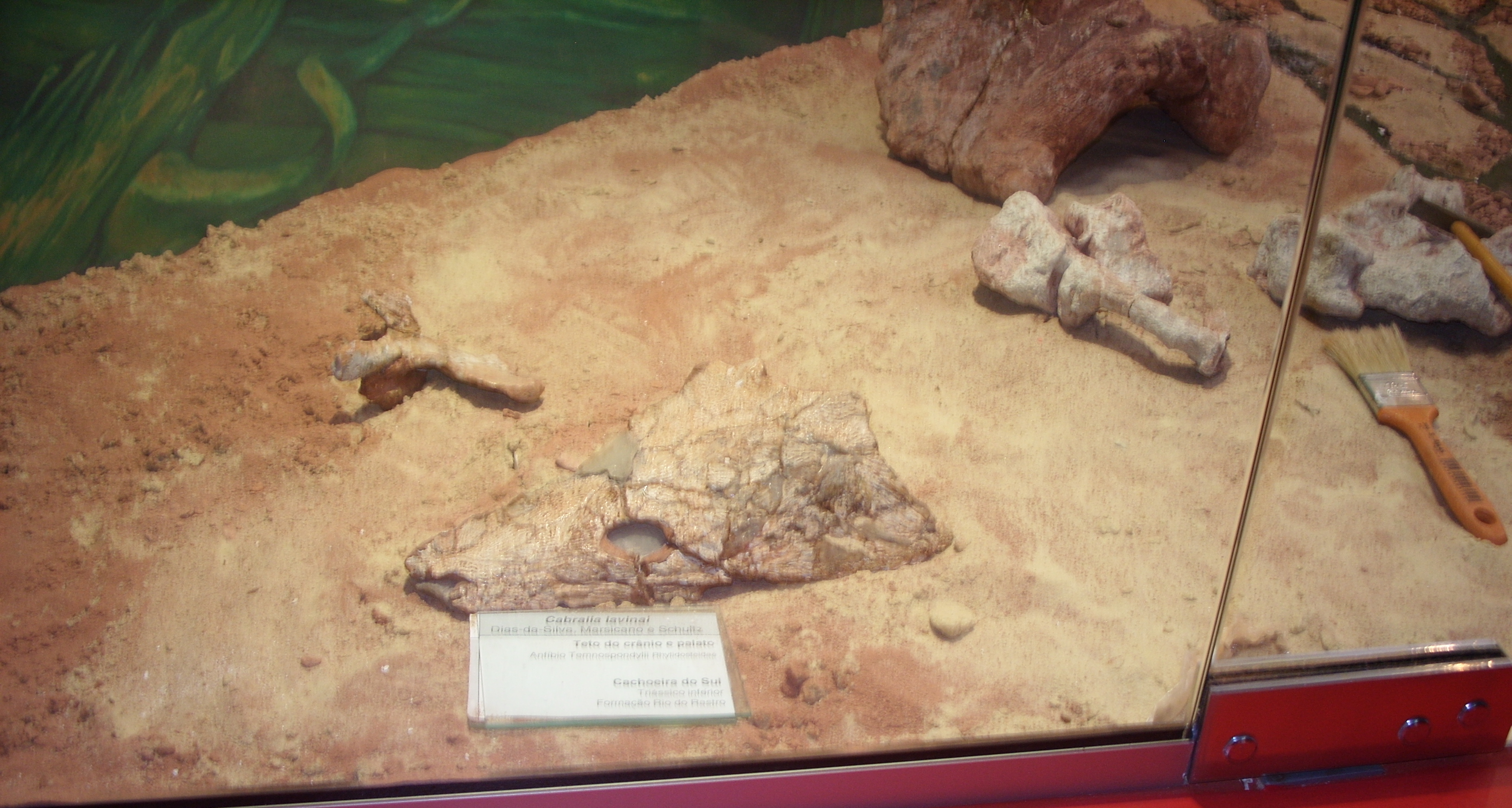분추목
"오늘의AI위키"의 AI를 통해 더욱 풍부하고 폭넓은 지식 경험을 누리세요.
1. 개요
분추목(Temnospondyli)은 중생대에 살았던 다양한 양서류의 한 분류군으로, 현존하는 양서류보다 크고 악어와 유사한 외모를 가진 종이 많다. 분추류는 석탄기 초기부터 트라이아스기-쥐라기 멸종까지 번성했으며, 두개골의 특징적인 구조와 척추의 형태, 피부와 골판의 발달 등으로 구분된다. 1888년 칼 알프레드 폰 지텔에 의해 명명되었으며, 척추뼈 구조에 따라 라키토미 아목과 고추아목으로 분류되기도 했으나, 계통발생학적 연구를 통해 현재는 다양한 과와 상과로 세분화된다. 분추류는 섭식, 생식, 성장 등에서 다양한 특징을 보이며, 현생 양서류와의 연관성에 대한 연구가 활발히 진행되고 있다.
더 읽어볼만한 페이지
| 분추목 - [생물]에 관한 문서 | |
|---|---|
| 분류 정보 | |
![[[에리옵스 메가케팔루스]] 골격](https://cdn.onul.works/wiki/noimage.png) | |
| 학명 | Temnospondyli |
| 명명자 | Zittel, 1888년 |
| 화석 범위 | 미시시피기 - 압트절, 진양서류의 가능한 후손이 현재까지 생존 |
| 분류군 순위 | 목 |
| 속하는 강 | 양서강 |
| 아강 | 미치아강 |
| 하위 그룹 | 본문 참조 |
| 어원 | (자르다) + (척추) |
2. 특징
많은 분추목은 현존하는 양서류보다 훨씬 크기가 컸으며, 겉모습은 악어와 유사한 경우가 많았다. 이 때문에 학명에 악어를 뜻하는 '-suchus'가 붙는 경우가 많다.[2] 가장 큰 종류 중 일부, 특히 중생대의 입체두류(Stereospondyli)는 두개골 길이가 1m를 넘고 전체 몸길이가 수 미터에 달했을 것으로 추정된다.[2][3][4][5] 반면, 양서목류(Amphibamiformes)나 마이크로멜러페톤과(Micromelerpetidae)처럼 현생 도롱뇽과 비슷하게 생긴 작은 종류도 있었다.[6][206]
일반적으로 넓고 평평한 머리를 가졌으며, 주둥이는 뭉툭하거나 길쭉했다. 두개골은 위에서 보았을 때 둥글거나 삼각형 모양인 경우가 많았고, 표면은 보통 구멍과 돌기로 덮여 있었다. 많은 분추류는 두개골에 감각구(sensory sulci)라 불리는 수로 같은 홈을 가지고 있었는데, 이는 물 속에서 진동을 감지하는 측선 시스템의 일부였다.[237][22][23][24][25][26][27] 두개골의 세부적인 구조와 기능에 대해서는 아래 문단에서 더 자세히 설명한다.
대부분의 분추류는 반수생 동물로, 앞발에 네 개, 뒷발에 다섯 개의 발가락을 가진 작은 다리를 가지고 있었다.[237] 육상 생활에 적응한 분추류는 더 크고 튼튼한 다리를 가졌으며, 일부는 발톱도 가지고 있었을 수 있다.[239] 특히 육상 분추류인 파옐라(Fayella)는 몸통에 비해 상대적으로 긴 다리를 가지고 있어, 먹이를 쫓아 활발하게 달렸을 것으로 추정된다.[240] 석탄기와 페름기 암석에서 발견되는 흔적화석인 바트라크이크누스(Batrachichnus)는 작은 분추류가 남긴 것으로 보이며, 주로 담수 환경 주변 지층에서 발견되어 이들이 물가 근처에서 생활했음을 시사한다.[243] 2007년 석탄기 펜실베니아기의 마우치 청크 층에서 발견된 분추류 몸 자국 화석은 이들이 매끈한 피부, 물갈퀴가 있는 발, 몸 아래쪽의 주름진 피부를 가졌음을 보여준다.[242]
현생 양서류와 달리 많은 분추류는 몸이 작고 촘촘한 비늘이나 커다란 배판(ventral plates)으로 덮여 있었다. 일부 그룹, 특히 육상 생활에 적응한 종류들은 등쪽에 골편(osteoderm)이라 불리는 뼈판을 가지고 있어 갑옷과 같은 역할을 하기도 했다.[245][246][247] 피부와 골판에 대한 자세한 내용은 아래 문단에서 설명한다.
분추류의 척추는 현생 네발동물과 달리 플루로센트룸(pleurocentrum)과 인터센트룸(intercentrum)이라는 여러 조각으로 나뉘어 있었다. 척추 구조는 크게 두 가지 형태로 나뉘는데, 육상 생활에 적합한 유연하고 여러 조각으로 나뉜 형태와 수생 생활에 적합한 단순화된 견고한 형태가 있었다.[249] 척추 구조에 대한 자세한 내용은 아래 문단에서 설명한다.
2. 1. 두개골
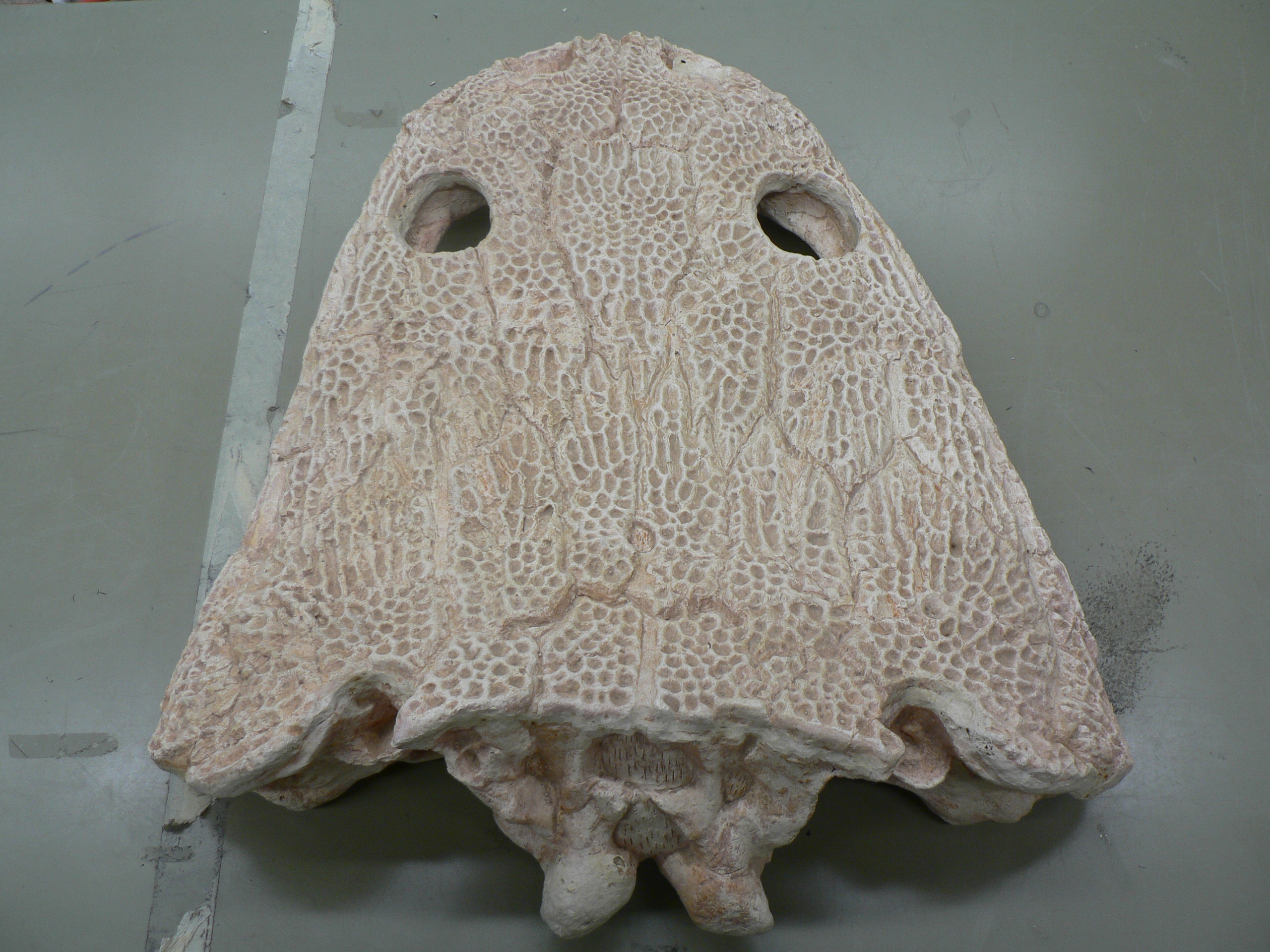
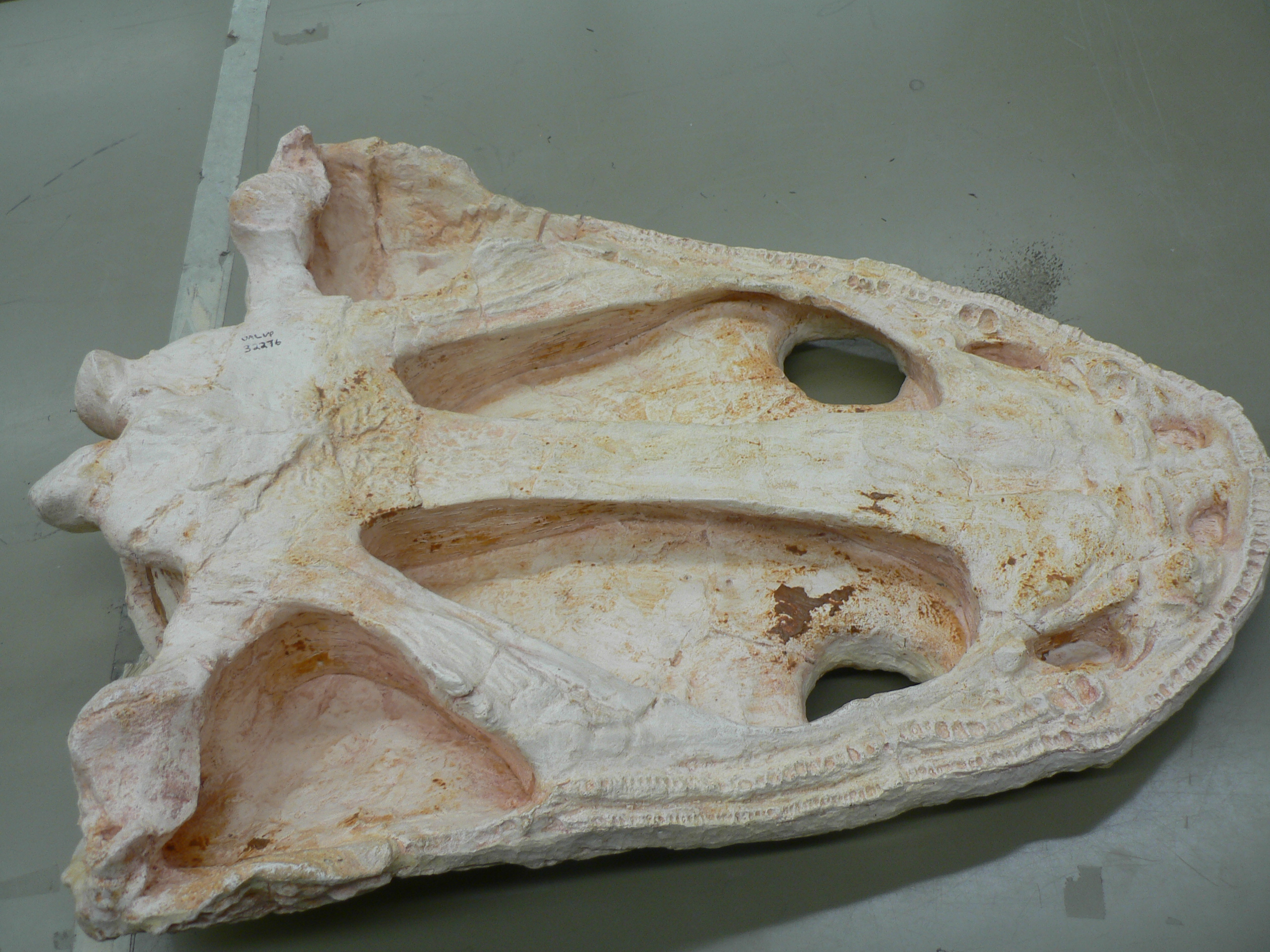
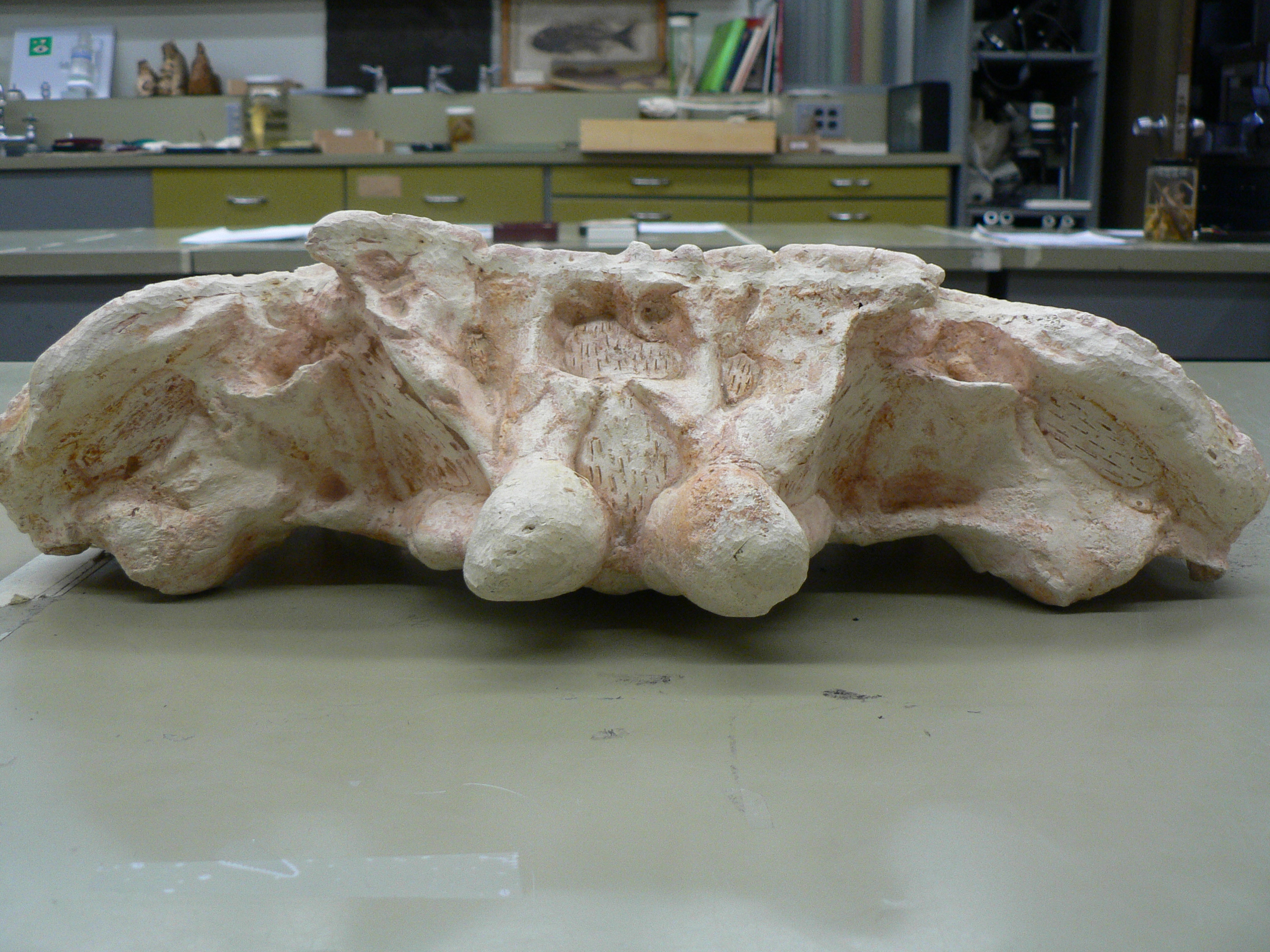
분추류의 두개골은 위에서 보았을 때 일반적으로 둥글거나 삼각형 모양이며, 넓고 평평한 머리를 가진 경우가 많다.[237] 주둥이는 뭉툭하거나 길쭉할 수 있다. 특히 물에 서식하는 종류는 두개골이 매우 납작하고 눈구멍(안와)이 등 쪽을 향하는 경향이 있다. 두개골 표면은 보통 구멍과 돌기(능선)로 덮여 있어 벌집 같은 패턴을 이루는데, 이 울퉁불퉁한 표면에 혈관이 분포했을 것으로 추정된다. 이는 이산화탄소를 뼈로 운반하여 혈액의 산성화를 막는 데 도움을 주었을 수 있다. 초기 네발동물은 육지에서 이산화탄소 배출에 어려움을 겪었을 수 있으며, 이러한 피부골 구조가 초기 해결책이었을 가능성이 제기된다.[238][7] 하지만 두개골 장식의 기능에 대해서는 피부 부착 면적 증가 등 다른 가설도 있으며[8], 현생 양서류에는 이 특징이 없어 정확한 기능은 아직 밝혀지지 않았다.[9][10][11][12][13][14] 일부 분추류(예: ''Micropholis'', 플라기오사우르류(plagiosaurids))는 구멍과 홈 대신 융기된 작은 돌기나 물집 모양 구조를 보이기도 한다.[6][15][215][16][17]

많은 분추류 두개골에는 감각구(sensory sulci)라고 불리는 수로 형태의 홈이 파여 있다. 이 홈은 주로 코와 눈 주변을 지나가며, 물속의 진동을 감지하는 측선 시스템의 일부로 기능했다.[237][18][19][20][21] 감각구의 존재는 해당 분추류가 수생 생활을 했을 가능성을 시사한다.[22][23][24][25][26][27] 육상 생활을 했을 것으로 추정되는 많은 종류는 콧등 끝 중앙에 인터나리얼 창(internarial fenestra) 또는 샘구멍(foramen)이라는 구멍을 가지는데, 이는 먹이를 잡는 데 사용되는 점액선을 수용했을 수 있다.[28] 자트라키스과(Zatracheidae)에서는 이 구멍이 매우 커져 있는데, 그 이유는 명확하지 않다.[29][30][31]
분추류 두개골의 뼈 대부분은 다른 초기 네발동물의 뼈와 상동 관계에 있다. 하지만 일부 분추류에서만 발견되는 뼈도 있는데, 간비골(internasals), 간전두골(interfrontals), 간두정골(interparietals) 등이 그렇다.[237][32][33][34][35] 초기 네발동물에 흔했던 간측두골(intertemporal)은 에도포이드상과(Edopoidea)나 드비노사우루스류(dvinosaur) 같은 일부 후기 고생대 분추류에서만 발견된다.[36][37][38][39] 대부분의 분추류는 두개골 뒤쪽에 테이블뼈(tabular bone)를 가지고 있으며, 이는 둥글게 튀어나와 있다. 자트라키스(Zatrachys) 같은 종류에서는 이 테이블뼈가 뾰족하고 길게 돌출되어 있다. 두개골 측면에는 큰 이개절(otic notch)이라는 함몰부가 있는 경우가 많은데, 육상종에서는 이곳에 고막이 붙어 청각 기관으로 기능했을 것으로 추정된다.[40][41][42][43][44][45] 하지만 이개절의 형태는 분추류 내에서도 다양하며[46][47], 플라기오사우르류(plagiosaurids)나 브라키오피드과(Brachyopidae)처럼 이개절이 없는 종류도 있다.[32] 디솔로푸스과(Dissorophidae)에서는 귀가 더욱 발달하여 현생 무미목(개구리 등)과 유사한 구조를 보인다.
분추류 두개골의 가장 두드러진 특징 중 하나는 입천장(palate) 뒤쪽에 있는 한 쌍의 매우 큰 구멍인 간익상골 빈 공간(interpterygoid vacuity)이다.[48][49][50] 이 구멍은 근육 부착 지점을 늘려주고, 현생 개구리나 도롱뇽처럼 눈알을 입천장 쪽으로 당겨 넣어 먹이를 삼키는 데 도움을 주었을 가능성이 있다.[51][52] 호흡을 위한 구강 펌프 작용의 증거는 발견되지 않았다. 간익상골 빈 공간 앞쪽에는 코아나(choana)라는 또 다른 한 쌍의 구멍이 있어 비강과 입을 연결한다. 자매군인 탄룡목과 달리, 뇌함과 입천장을 잇는 기저 관절의 가동성은 없다.
분추류는 턱뿐만 아니라 입천장에도 이빨이 넓게 나 있는 경우가 많았다.[53][54] 이 중 일부는 매우 커서 엄니(tusk) 또는 송곳니(fang)라고 불린다. 니게르페톤(Nigerpeton), 드비노사우루스류 ''Erpetosaurus'', 카피토사우루스류(Capitosauria) ''마스토돈사우루스(Mastodonsaurus)'', 트레마토사우루스류(Trematosauria) ''Microposaurus'' 등 일부 분추류는 아래턱의 엄니가 입천장을 뚫고 두개골 위쪽의 구멍으로 솟아나 있기도 했다.[241][4][57][58] 대부분의 분추류는 끝이 하나인 단첨치(monocuspid)를 가졌지만, 일부 디소로포이드류(dissorophoids)는 끝이 두 개인 이첨치(bicuspid)나 뿌리 부분과 끝부분이 분리된 유병치(pedicellate)를 가지고 있었다. 이는 이들이 현생 양서류(리삼피비아)와 가까운 관계일 수 있다는 증거로 제시되기도 한다.[206][28][207][55][56][211]
2. 2. 척추
분추류의 척추는 여러 부분으로 나뉜다. 현생 네발동물의 척추뼈 몸통은 센트룸이라고 불리는 하나의 뼈로 이루어져 있지만, 분추류의 척추뼈 몸통은 플루로센트룸과 인터센트룸이라는 두 부분으로 나뉜다. 분추류의 척추뼈는 크게 두 가지 형태로 구분할 수 있는데, 견고한 형태와 여러 조각으로 나뉜 형태가 있다.여러 조각으로 나뉜 형태의 척추에서는 인터센트룸이 크고 쐐기 모양이며, 플루로센트룸은 상대적으로 작아 그 사이에 끼어 있다. 이 두 요소는 함께 척추뼈고리(neural arch)라는 돌기 구조를 받치고 있다. 또한, 관절돌기라고 불리는 서로 맞물리는 부분이 잘 발달하여 척추뼈 사이의 연결을 강화한다. 이런 형태의 척추뼈를 가진 분추류는 강력한 척추와 네 다리를 가지고 있어, 부분적으로 또는 완전히 육상 생활을 할 수 있었다.
반면, 견고한 형태의 척추를 가진 종류에서는 플루로센트룸이 완전히 사라지고 인터센트룸이 커져 척추뼈의 몸통 전체를 이룬다. 이러한 형태의 척추뼈는 상대적으로 약해서, 견고한 척추뼈를 가진 분추류는 주로 물 속에서 생활했을 것으로 추정된다.[249]
2. 3. 피부와 골판
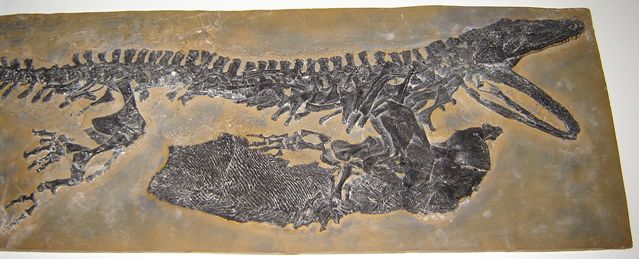
현생 양서류와 달리 많은 분추류는 작고 촘촘한 비늘로 덮여 있었다.[244] 일부 분추류는 조상인 어류처럼 피부에 뼈 성분의 비늘을 가지고 있었지만, 후대로 갈수록 비늘이 없는 종이 늘어나는 경향을 보였다. 이들은 현생 양서류와 같이 매끄러운 피부를 가졌을 것으로 추정된다. 실제로 석탄기 펜실베니아기의 마우치 청크 층에서 발견된 분추류 몸 자국 화석은 이들이 살아있을 때 매끈한 피부와 몸 아래쪽에 주름진 피부를 가졌음을 보여준다.[242] 특히 트레마토사우르나 카피토사우르류와 같이 후기에 등장한 반수생 분추류는 비늘이 없었을 가능성이 있는데, 이는 물속에서의 움직임을 용이하게 하거나 피부호흡을 위한 적응으로 여겨진다.[244]
대부분의 분추류는 배쪽이 커다란 배판(ventral plates)으로 덮여 있었다.[244] 이 배판은 발달 초기에는 작고 둥근 비늘 형태였으나, 성장하면서 크고 넓게 발달했다. 이 판들은 서로 겹쳐져 있어 몸을 유연하게 움직일 수 있게 했다.[244]
분추류 내의 몇몇 그룹은 등쪽에 커다란 골판(bony plates)을 가지고 있었다. 펠토바트라쿠스는 등과 배 양쪽에 모두 갑옷과 유사한 판을 가지고 있었으며,[245] 라이드레리라 역시 등에 골판을 가지고 있었다.[245] 디소로피드과(Dissorophidae)에 속하는 동물 대부분도 갑옷 같은 골판을 가졌는데, 이는 등 중심선을 따라 두 줄로 좁게 배열되어 있었다.[246] 에리옵스와 같은 다른 분추류는 작은 원반 모양의 골편(scute)을 가지고 있었는데, 이는 살아있을 때 피부 속에 박혀 있었을 것으로 추정된다.[247] 이러한 갑옷 구조는 주로 육상 생활에 적응한 분추류에게서 나타나며, 펠토바트라쿠스의 경우처럼 포식자로부터 자신을 보호하는 역할을 했을 것으로 보인다.[245] 골편은 몸의 유연성을 일부 제한했을 수 있으나, 강력한 인대로 연결되어 척추의 안정성을 높이는 데 기여했을 수도 있다.[247] 수생 생활을 했을 것으로 보이는 플라기오사우르류에서도 골편이 발견되는데, 이는 육상 생활을 하던 조상으로부터 물려받은 특징일 가능성이 있다.[245]
3. 연구사
분추류(Temnospondyli)라는 이름은 독일 고생물학자 칼 알프레드 폰 지텔이 1888년 출판한 그의 저서 "고생물학 핸드북" 2판에서 처음 사용했다. 분추류 자체는 19세기 초반부터 알려져 있었다. 가장 먼저 기술된 분추류는 ''마스토돈사우루스''(''Mastodonsaurus'')로, 1828년 게오르그 프리드리히 예거가 단 하나의 이빨 화석을 바탕으로 명명했다. 예거는 처음에 이를 파충류로 생각했으며, '마스토돈사우루스'라는 이름은 "가슴 같은 이빨을 가진 도마뱀"이라는 뜻으로, 이빨 끝부분이 유두처럼 생긴 모양에서 유래했다.[119][250]
이 초기 표본의 명명 과정에는 논란이 있었다. 1837년 레오폴트 피칭거는 이 동물을 ''바트라코사우루스''(''Batrachosaurus'')라고 명명했고, 1841년 영국의 저명한 고생물학자 리처드 오언은 복잡하게 접힌 미로 모양의 이빨 구조 때문에 ''라비린토돈''(''Labyrinthodon'')이라는 이름을 제안했다. 오언은 '마스토돈사우루스'라는 이름이 포유류인 마스토돈을 연상시키고, 파충류를 뜻하는 '사우루스' 접미사가 당시 양서류를 포함하던 '바트라키아'(Batrachia) 목에 속하는 이 동물에게 부적절하다고 주장했다.[120][251] 오언은 이 동물이 도마뱀과 같은 '사우리아'(Sauria) 파충류가 아님을 인지했지만, 예거가 명명한 ''피토사우루스''(''Phytosaurus'')도 유사한 종류로 보았다. 이후 두개골을 포함한 더 많은 화석이 발견되면서 라비린토돈은 명확히 양서류로 분류되었다. 한편, 예거는 1828년에 두개골 뒷부분 표본을 ''살라만드로이데스 기간테우스''(''Salamandroides giganteus'')로 명명했고, 1833년에는 이 종의 완전한 두개골을 기술했는데, 이것이 마스토돈사우루스와 동일한 이빨을 가졌음이 밝혀졌다. 결과적으로 가장 먼저 명명된 ''마스토돈사우루스''가 우선권을 가지게 되었다.[121][252] ''바트라코사우루스''라는 이름은 현재 다른 브라키오피드 분추류의 속명으로 사용되고 있다.
''마스토돈사우루스''와 유사한 동물들은 복잡한 이빨 구조 때문에 '미로이빨류'(labyrinthodont)라고 불렸다. 오언은 영국 가이즈 클리프(Guy's Cliffe)와 워릭셔 등에서 발견된 화석들을 연구하며 미로이빨류를 양서류 중 가장 진화한 형태로 보았고, 파충류 중 가장 고등하다고 여겨졌던 악어와 비교하기도 했다. 그는 또한 케우퍼(Keuper)층(후기 트라이아스기)의 거대한 미로이빨류가 마그네시안 석회암과 체히슈타인(후기 페름기)의 더 진화된 파충류보다 나중에 나타났다는 점을 지적하며, 파충류가 초기 양서류로부터 점진적으로 진화했다는 당시의 생각을 반박하는 근거로 삼았다.[122][253]
''마스토돈사우루스'' 외에도 19세기 중반에 ''메토포사우루스''(''Metoposaurus'', 당시 ''Metopias''), ''지고사우루스''(''Zygosaurus''), ''트레마토사우루스''(''Trematosaurus''), ''바페테스''(''Baphetes''), ''덴드레르페톤''(''Dendrerpeton''), ''카피토사우루스''(''Capitosaurus''), ''다시셉스''(''Dasyceps'') 등 여러 속들이 명명되었다.[123][254] 이 중 ''바페테스''와 ''롬보폴리스''(''Rhombopholis'')는 현재 분추류가 아닌 다른 그룹(초기 사지동물, 전도마뱀류 파충류)으로 재분류되었다.[124][255][256]
19세기 후반, 분추류는 대부분 에드워드 드링커 코프가 1868년에 제안한 견두류(Stegocephalia)의 일원으로 분류되었다. '견두류'는 "지붕 머리"라는 뜻으로, 이들 동물의 넓고 평평한 머리 모양에서 유래했다. 당시 고생물학자들은 어린 개체에서 발견되는 아가미 활, 흉곽 아래쪽에서 연결되지 않는 갈비뼈, 점액선을 위한 것으로 보이는 두개골의 깊은 구멍 등을 근거로 분추류를 양서류로 간주했다.[126][257]
이 시기에는 견두류 내에 여러 아목이 제안되었다. 현재 분추류로 분류되는 동물들은 주로 미로이빨류로 불렸으나, 일부 작은 형태는 브란키오사우리아(Branchiosauria)로 분류되기도 했다. 브란키오사우리아는 작은 몸집, 단순한 이빨, 미성숙한 뼈, 외부 아가미 등의 특징을 가졌는데, 나중에는 이들이 분추류의 유생 형태이거나 유형성숙의 예로 밝혀져 독립된 그룹으로 인정받지 못하게 되었다.[127][128] 일부 분추류는 '가노케팔라'(Ganocephala)라는 그룹으로 분류되기도 했는데, 이들은 판 모양의 두개골, 작은 다리, 물고기 같은 비늘, 아가미 활 등을 특징으로 하며 가장 원시적인 파충류의 일종으로 여겨지기도 했다.[129][259] 또한 코프는 작은 양서류들을 세룡류(Microsauria)로 분류했는데, 여기에는 ''덴드레르페톤''처럼 한때 가노케팔라로 분류되었던 종도 포함되는 등 초기 양서류 분류에는 상당한 혼란이 있었다.[130][260]
19세기 말에는 오늘날 분추류로 간주되는 동물 대부분이 미로이빨아목으로 분류되었고, 미국 고생물학자 어민 카울스 케이스는 이를 "진정한 미로이빨류"(''Labyrinthodonta vera'')라고 불렀다.[131][261] 미로이빨류 내에서는 척추 구조에 따라 라키토미(Rhachitomi, 척추가 여러 조각으로 나뉨), 라비린토돈티(Labyrinthodonti, 척추 중심체가 하나로 합쳐짐), 엠볼로메리(Embolomeri, 두 개의 중심체가 비슷한 크기) 등으로 세분화되었다. 이 중 엠볼로메리류는 현재 분추류와는 거리가 먼 파충형류(Reptiliomorpha) 또는 줄기군 사지동물로 분류된다.[190][191]
1888년, 폰 지텔은 견두류를 척추 구조에 따라 공추류(Lepospondyli, 단순한 실패 모양 척추), 분추류(Temnospondyli, 중심체가 둘로 나뉨), 전추류(Stereospondyli, 중심체가 하나이며 앞뒤가 오목함)로 나누었다.[132] 그는 세룡류를 공추류에 포함시켰다. 코프는 공추류와 전추류의 척추 구분이 모호하다며 지텔의 분류에 반대했지만, '분추류'라는 이름 자체는 20세기 초에 점차 사용되기 시작했다.[133][262]
1919년, 영국의 고생물학자 D.M.S. 왓슨은 이들 거대 양서류의 진화 역사가 척추 구조의 변화, 즉 석탄기의 엠볼로메리 형태에서 페름기의 라키토미 형태를 거쳐 트라이아스기의 전추류 형태로 이어지는 과정으로 설명될 수 있다고 주장했다. 그는 이 전체 그룹을 지칭하기 위해 '미치류'(Labyrinthodontia)라는 용어를 다시 널리 사용하게 만들었고, 이로 인해 '분추류'라는 이름은 수십 년간 거의 사용되지 않았다.[134][264] 이후 스웨덴 고생물학자 군나르 새비-소더버그는 엠볼로메리를 제외하고 라키토미와 전추류만을 포함하는 좁은 의미(sensu stricto)로 미치류를 재정의했다.[133]
20세기 후반, 미국의 저명한 고생물학자 알프레드 로머는 '분추류'(Temnospondyli)라는 이름을 다시 적극적으로 사용하기 시작했다. 그는 새비-소더버그의 분류에는 동의했지만, '미치류'라는 용어가 넓은 의미(sensu lato)와 좁은 의미로 혼용되어 혼란을 야기할 수 있다고 보아 '분추류'를 선호했다. 다만 로머의 초기 분추류 개념에는 현재 분추류에 포함되지 않는 원시적인 이크티오스테갈리아(Ichthyostegalia) 등이 포함되기도 했다.[133][263]
최근 분추목 연구는 주로 이들의 고생물학적 특성과 내부 계통 관계를 밝히는 데 집중되고 있다. 컴퓨터를 이용한 계통발생학적 분석 방법이 발달하면서 분추목 전체[186][193][1] 및 특정 하위 그룹[141][142][143][144][163][145]의 진화적 관계에 대한 이해가 크게 깊어졌다. 또한 형태 계측,[146][147][148][149] 생체 역학[150][151] 등 다양한 정량적 분석 기법이 도입되고 있다.
분추목 화석은 전 세계적으로 발견되며, 20세기 후반과 21세기에 들어 남극,[152][176] 레소토,[153] 일본,[154] 나미비아,[155] 뉴질랜드,[156] 니제르,[196] 튀르키예[157] 등 과거에는 화석 기록이 부족했던 지역에서도 새로운 발견이 이어지면서 이들의 지리적, 시대적 분포 범위가 계속 확장되고 있다.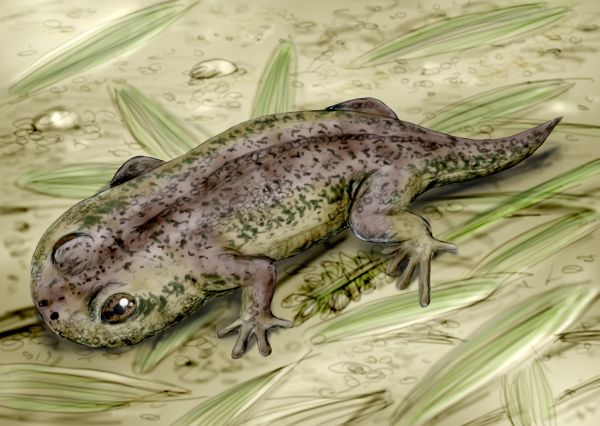
분추목 연구에서 가장 활발한 주제 중 하나는 현생 양서류(개구리, 도롱뇽, 무족영원을 포함하는 리삼피비아, Lissamphibia)의 기원과 분추목과의 관계이다.[212][136][137][138][139][140] 현생 양서류의 기원에 대해서는 크게 세 가지 가설이 있다. 첫째는 분추목에서 진화했다는 것이고, 둘째는 렙토스폰딜리(Lepospondyli)라는 다른 초기 양서류 그룹에서 진화했다는 것이며, 셋째는 무족영원은 렙토스폰딜에서, 개구리와 도롱뇽은 분추목에서 각각 진화했다는 혼합 기원설이다.[203][204][205][206]
최근에는 많은 증거들이 모든 현생 양서류가 분추목 내의 특정 그룹, 특히 디소로포상과(Dissorophoidea)에 속하는 암피바미과(Amphibamidae)에서 기원했다는 첫 번째 가설을 지지하고 있다. 이 가설을 뒷받침하는 중요한 증거 중 하나는 '기둥니'라고 불리는 독특한 이빨 구조이다. 이 이빨은 석회화된 끝부분(crown)과 뿌리(base) 사이에 석회화되지 않은 연한 조직층이 존재하는데, 이러한 구조는 현생 양서류와 암피바미과를 포함한 일부 분추목에서 공통적으로 발견된다.[207][208]
특히 1969년에 발견된 ''돌레르페톤''(''Doleserpeton'')과 2008년에 기술된 ''게로바트라쿠스''(''Gerobatrachus'')와 같은 암피바미과 화석들은 현생 양서류와의 유사성을 뚜렷하게 보여준다. ''게로바트라쿠스''는 개구리 같은 넓은 머리와 도롱뇽 같은 몸통을 가져 "프로그맨더"(frogmander, 개구리도롱뇽)라는 별명을 얻기도 했다. ''돌레르페톤''은 기둥니 외에도 현생 양서류와 유사한 고막 구조, 구개 구조, 짧은 갈비뼈 등을 가지고 있어 리삼피비아의 직계 조상에 매우 가까운 형태로 여겨진다.[207][209][210][211]
하지만 최근 ''친레스테고피스''(''Chinlestegophis'')와 같은 트라이아스기 전추류(Stereospondyli) 화석이 현생 무족영원(caecilian)과 유사한 특징을 보인다는 연구 결과가 나오면서, 모든 현생 양서류가 단일 분추목 그룹에서 유래한 것이 아니라, 개구리와 도롱뇽은 암피바미과에서, 무족영원은 전추류에서 각각 독립적으로 진화했을 가능성도 다시 제기되고 있다. 이 가설이 맞다면, 현생 양서류는 분추목 내의 서로 다른 두 계통이 살아남은 결과가 된다.[212] 이처럼 분추목과 현생 양서류의 관계는 여전히 활발한 연구와 논쟁이 진행 중인 분야이다.
4. 진화사
분추목은 고생대 석탄기 초기인 약 3억 3천만 년 전에 처음 지구 상에 나타났다.[158][159] 석탄기 동안에는 덴드레페톤과 같이 육상 생활에 비교적 적응한 중간 크기의 초기 형태와 코클레오사우루스처럼 물가에 서식하는 대형 반수생 형태들이 등장하며 점차 다양해지기 시작했다. 일부는 도롱뇽과 비슷한 작은 크기로 육상 생활에 더 적합한 모습을 보이기도 했다.
페름기에 접어들면서 분추목은 더욱 번성하여 다양한 서식 환경에 적응했다. 디소로피드나 트레마토피드처럼 육상 생활에 완전히 적응하여 견고한 팔다리와 척추를 가진 그룹이 나타나는가 하면, 에리오피드와 같이 몸집이 큰 반수생 포식자들도 진화했다. 또한, 일부는 육상 생활을 하던 조상으로부터 다시 물 속 생활에 적응하는 드비노사우루스류 같은 소형 수생 그룹도 나타났다.[265]
중생대 트라이아스기에는 고추류(Stereospondyli)라는 주요 그룹이 크게 번성하며 민물 생태계의 지배적인 위치를 차지했다. 이들은 점차 물 속 생활에 더욱 의존하게 되면서 척추뼈가 약해지고 다리가 작아졌으며, 대신 머리가 크고 납작해지는 등 수생 환경에 특화된 형태로 진화했다.[174] 일부 트레마토사우로이드는 바다까지 진출하기도 했으며,[175] 마스토돈사우루스와 같은 거대한 포식자도 등장했다.
그러나 약 2억 년 전 발생한 트라이아스기-쥐라기 멸종 사건으로 인해 대부분의 분추목 그룹이 자취를 감추었다.[2][182][183] 이후 쥐라기와 백악기까지 일부 그룹(브라키오포이드)이 명맥을 유지했으나 점차 쇠퇴하였다. 가장 마지막까지 살아남은 분추목은 백악기 전기 호주 지역에 서식했던 거대한 쿨라수쿠스로, 약 1억 1천만 년 전에 멸종한 것으로 알려져 있다.[184] 이처럼 분추목은 고생대 후기부터 중생대 초중반까지 약 2억 년 이상 지구의 다양한 수생 및 육상 환경에서 번성했던 중요한 양서류 그룹이었다.
4. 1. 석탄기 및 페름기 초기
최초의 분추목은 석탄기 전기 로라시아 대륙에서 원시적인 사지형류인 익티오스테가목으로부터 갈라져 나온 것으로 추정된다. 가장 오래된 시기에는 전체 길이 약 1m 정도의 중간 크기 육상종인 덴드레르페톤과 1.5m를 넘는 대형 반수생종인 코클레오사우루스 등이 알려져 있으며, 이들을 시작으로 다양한 환경으로 퍼져나갔다.분추목은 약 3억 3천만 년 전인 미시시피기 중기(비제안)에 처음 등장한 것으로 확인된다. 가장 초기의 사례로는 스코틀랜드의 ''발라네르페톤''과 독일에서 발견된 아직 종이 특정되지 않은 분추목 화석이 있다.[158][159][160][161]
석탄기 동안 덴드레르페티드, 에도포이드, 에리오포이드, 다양한 디소로포이드 하위 분류군, 드비노사우루스, 자트라키디드를 포함한 주요 분기군들이 나타났다.[80] 특히 후기 석탄기에는 대부분의 분기군이 번성했으며, 그중에서도 디소로포이드의 다양성이 두드러졌다. 스테레오스폰딜로모르프와 스테레오스폰딜은 페름기 초기에 처음 등장했지만, 스테레오스폰딜로모르프는 더 이른 시기에 나타났을 가능성도 제기된다.[162][163][164]
석탄기 분추목 화석 기록의 대부분은 미국 중서부(린턴, 파이브 포인트, 메이존 크릭의 라거슈테테)와 남중부의 고전적인 적색층, 그리고 서유럽, 특히 독일의 자르-나헤 분지와 체코의 니르자니 지역에서 발견된다. 초기 페름기의 기록 역시 이 지역들에 집중되어 있다.
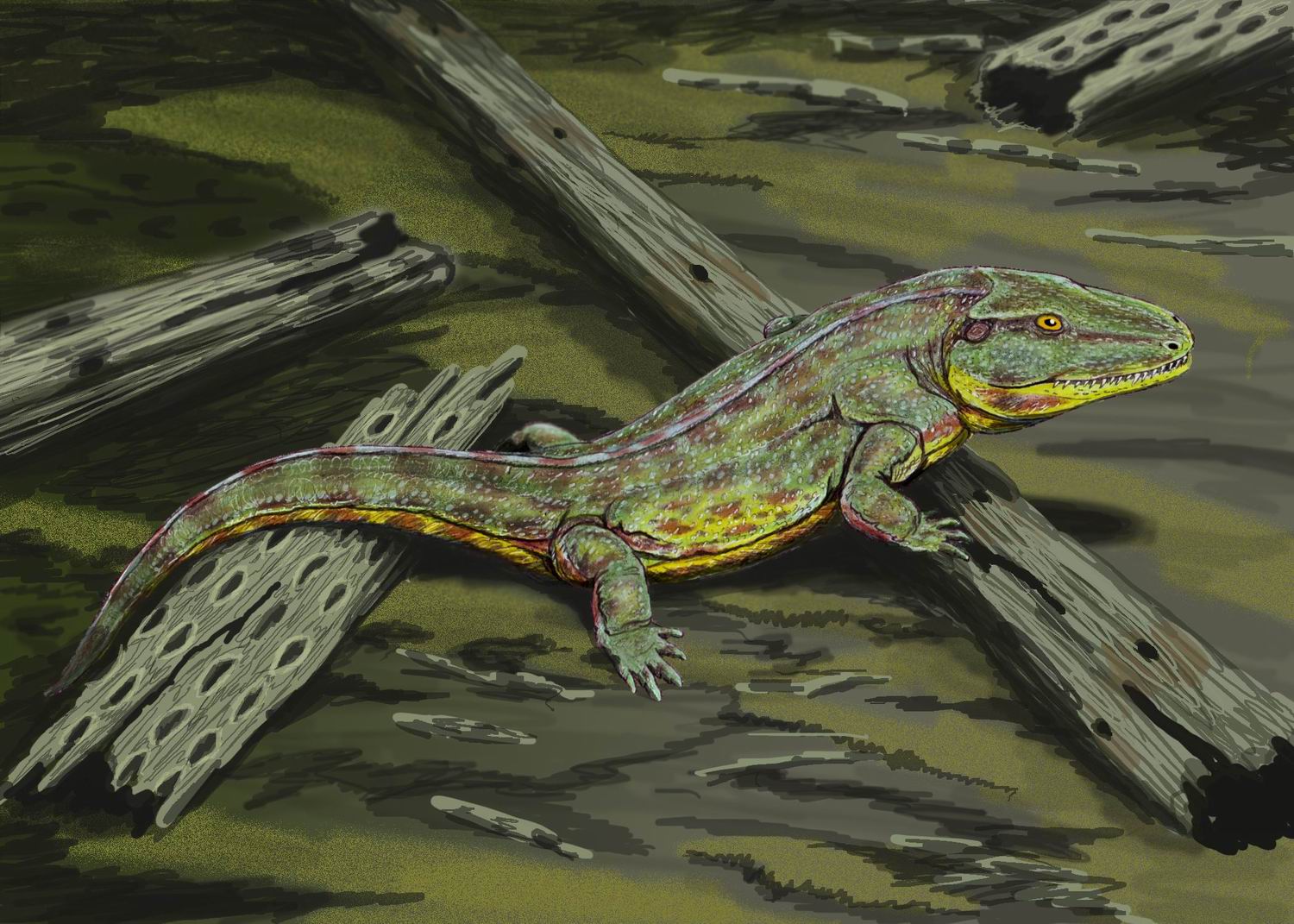
4. 2. 페름기 후기
후기 페름기 동안 기후가 점차 건조해지고 파충류가 다양해지면서, 육상 생활에 적응했던 측두골 하강류 분추목은 감소하는 경향을 보였다.[172] 하지만 반수생 및 완전 수생 스테레오스폰딜로모르프 분추목은 계속해서 번성했는데, 동유럽에서 발견된 거대한 '''멜로사우루스'''가 대표적이다.[172]아르케고사우루스류와 같은 일부 분추목은 현생 악어와 유사하게 긴 주둥이를 발달시켰으나, 악어의 특징인 단단한 갑옷(골판)은 없었다.[172] 이들은 당시 하천이나 호수 등 수중 환경에서 현생 악어와 비슷한 생태적 지위를 차지했던 것으로 보인다. 수생 환경에 적응하면서 척추는 약하고 단순한 형태(전추형, stereospondyli)로 변하고 사지가 짧아졌으며, 몸은 더 평평해지는 경향을 보였다.
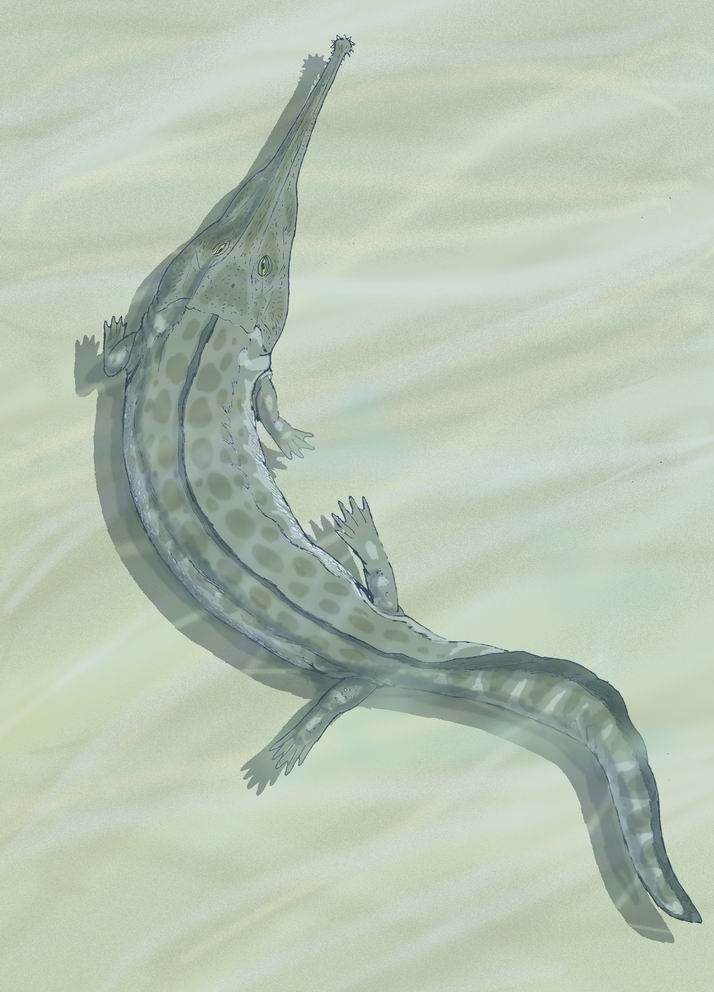
이 시기 분추목 중에는 브라질에서 발견된 '''프리오노수쿠스'''(Prionosuchus)가 포함되는데, 몸길이가 9m에 달하는 것으로 추정되어 지금까지 알려진 가장 큰 양서형류로 여겨진다.[172] 또한, 게로바트라쿠스(Gerobatrachus)와 같이 현생 양서류의 조상으로 여겨지는 특징을 가진 종도 나타났다. 후기 페름기의 스테레오스폰딜류 화석 기록은 주로 리네수쿠스류에 국한되어 발견된다.[173]
4. 3. 중생대
페름기 후기(2억 6000만 년 전 ~ 2억 5100만 년 전)부터 분추목은 계속 번성하고 다양해졌으며, 특히 고추류(Stereospondyli)라는 주요 그룹은 물 속 생활에 더욱 의존하게 되었다. 이들의 척추뼈는 약해졌고[174] 다리는 작아졌으며, 두개골은 크고 납작해져 눈이 위쪽을 향하게 되었다. 트라이아스기 동안 이들은 민물 생태계를 지배하며 다양한 크기와 형태로 진화했다.트라이아스기 초기(2억 5100만 년 전 ~ 2억 4500만 년 전)에는 긴 주둥이를 가진 어식성 그룹인 트레마토사우로이드(Trematosauroidea)가 바다까지 진출했는데, 이는 현생 게잡이 개구리를 제외하면 유일하게 바다에서 생활한 양서류로 알려져 있다. 또 다른 그룹인 카피토사우로이드(Capitosauroidea)는 몸길이가 2.3m 에서 4m에 달하는 중대형 동물이었으며, 가장 큰 종류인 마스토돈사우루스(Mastodonsaurus)는 1m가 넘는 크고 납작한 두개골을 가졌다. 이들은 생애의 대부분 또는 전부를 물 속에서 보내는 수중 포식자였으며, 위턱을 빠르게 열어 물고기나 작은 동물들을 입 안으로 빨아들여 사냥했다.[175]
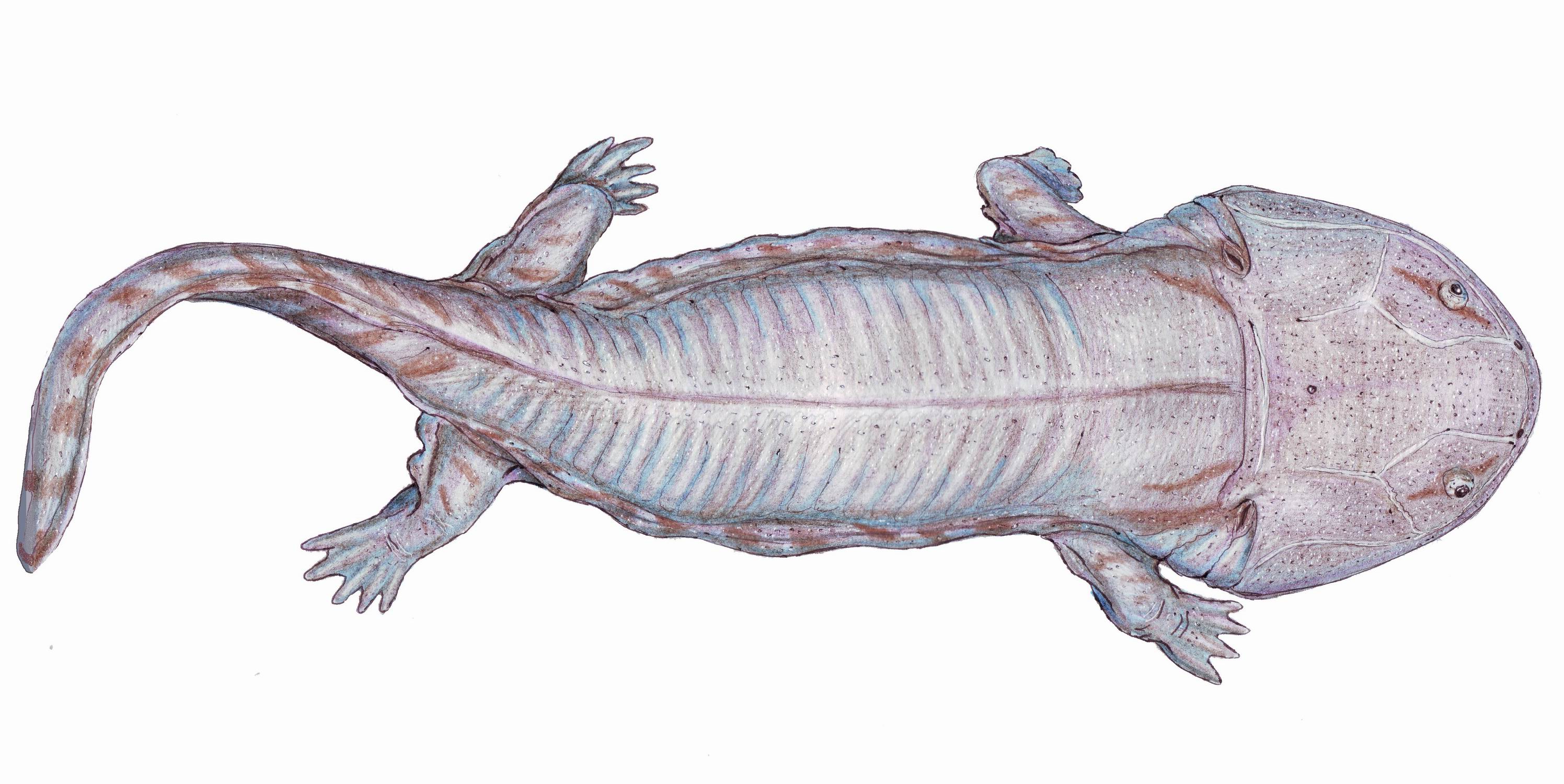
트라이아스기 후기의 카르니아절(2억 3700만 년 전 ~ 2억 2700만 년 전)에는 카피토사우로이드와 외형상 매우 유사한 메토포사우리드(Metoposauridae)가 등장했다. 메토포사우리드는 눈구멍이 두개골 앞쪽에 위치한다는 점에서 카피토사우로이드와 구별된다. 또 다른 고추류 그룹인 플라기오사우르(Plagiosauria)는 넓은 머리와 아가미를 가지고 호수나 강의 바닥 생활에 적응했다. 이 시기 분추목은 반수생 생태계에서 흔하고 널리 퍼진 구성원이었다. 크리오바트라쿠스(Cryobatrachus)나 크리오스테가(Kryostega)와 같은 일부 분추목은 당시 온대림으로 덮여 있던 남극에 서식하기도 했다.[176][177] 트라이아스기 분추목은 그들의 환경에서 지배적인 반수생 동물이었으며, 미국 남서부, 모로코, 인도, 서유럽 등지에서는 수백 마리의 메토포사우리드 개체가 함께 보존된 대규모 화석 군집이 발견되기도 했다.[178][179][180][181] 이는 과거 범람원 환경에서 가뭄으로 인한 대량 사망 사건으로 해석되었으나, 최근 연구에서는 죽은 개체들이 물살에 의해 특정 지역에 운반 및 축적된 결과일 가능성도 제기되었다.[178]
트라이아스기-쥐라기 멸종(약 1억 9960만 년 전) 때 대부분의 중생대 분추목이 멸종했다. 하지만 브라키오포이드(Brachyopoidea)와 일부 카피토사우로이드 및 트레마토사우로이드는 살아남았다.[2][182][183] 이후 카피토사우로이드와 트레마토사우로이드는 곧 멸종했고, 브라키오포이드들은 쥐라기에 몸집이 커졌다. 브라키오포이드 중에서는 브라키오피드(Brachyopidae)인 Gobiops와 Sinobrachyops가 아시아의 중기 쥐라기 및 후기 쥐라기 지층에서 발견되었으며, 키구티사우리드(Chigutisauridae)인 시더롭스(Siderops)는 호주의 초기 쥐라기에서 발견되었다.[182]
가장 마지막까지 살아남은 분추목은 거대한 키구티사우리드인 쿨라수쿠스(Koolasuchus)로, 호주의 백악기 전기(압트절, 약 1억 1000만 년 전) 지층에서 발견된다. 쿨라수쿠스는 열곡(rift valley)에서 살아남았는데, 당시 이 지역은 겨울철 기온이 낮아 경쟁자였을 악어형류가 살기에는 너무 추운 환경이었기 때문으로 추정된다. 쿨라수쿠스는 브라키오포이드 중 가장 큰 종류 중 하나로, 몸무게가 500kg에 달했을 것으로 추정된다.[184]
5. 분류
분추목의 분류는 역사적으로 척추뼈 구조에 기반하여 이루어졌다. 여러 개의 개별 요소로 구성된 복잡한 척추를 가진 초기 형태는 라키토미 아목(Rachitomi)으로 분류되었고, 단순화된 척추를 가진 트라이아스기의 대형 수생 형태는 고추아목(Stereospondyli)으로 분류되었다.[273][274] 이러한 분류 방식은 19세기 후반 에드워드 드링커 코프나 카를 알프레트 폰 치텔과 같은 학자들에 의해 처음 시도되었으며, 20세기 초 D. M. S. 왓슨 등은 척추 구조의 변화를 분추목 진화의 주요 단계로 해석하기도 했다.[132][134]
하지만 계통발생학 연구가 발전하면서 척추뼈 구조만으로는 분추목의 복잡한 진화적 관계를 정확히 반영하기 어렵다는 점이 밝혀졌다. 라키토미 형태의 척추뼈는 분추목뿐만 아니라 다른 여러 원시 네발동물에서도 나타나는 특징이며, 라키토미와 고추류형 척추뼈 사이의 구분 또한 명확하지 않기 때문이다. 어떤 분추류는 개체 내에서도 다양한 형태의 척추뼈를 가지기도 한다.[273][274][185][186] 이러한 이유로 라키토미는 더 이상 단일한 분류군으로 인정되지 않는다. 반면, 고추아목(Stereospondyli)은 여전히 분추목 내의 특정 분지군을 지칭하는 유효한 분류군으로 사용되고 있다.[273][274]
현재 분추목의 분류는 주로 계통발생학적 분석 결과를 바탕으로 이루어진다. 이를 통해 에돕스상과(Edopoidea), 덴드레페톤과(Dendrerpetontidae), 드비노사우리아(Dvinosauria), 에우스켈리아(Euskelia), 림나르키아(Limnarchia) 등 다양한 주요 그룹들이 설정되었으며, 이들 그룹 내의 세부 분류와 상호 관계는 지속적인 연구를 통해 업데이트되고 있다.[186][1] 분추목 내의 구체적인 계통 관계와 상세한 분류 체계에 대한 자세한 내용은 하위 계통발생 섹션에서 다룬다.
5. 1. 계통발생
분추류는 전통적으로 척추뼈 구조에 따라 분류되었다. 여러 요소로 구성된 복잡한 척추뼈를 가진 초기 형태는 라키토미 아목(Rachitomi)으로, 단순한 척추뼈를 가진 트라이아스기의 대형 수생 분추류는 고추아목(Stereospondyli)으로 분류되었다. 그러나 계통발생학의 발전으로 이러한 분류는 더 이상 유효하지 않다. 라키토미 형태의 척추뼈는 여러 원시 네발동물에서도 발견되며, 라키토미와 고추류형 척추뼈 사이의 구분도 명확하지 않다. 일부 분추류는 한 개체 내에서도 다양한 형태의 척추뼈를 가지며, 중간 형태도 존재한다. 라키토미는 더 이상 단일 그룹으로 인정되지 않지만, 고추류는 여전히 유효한 분류군으로 간주된다.[273][274][185][186]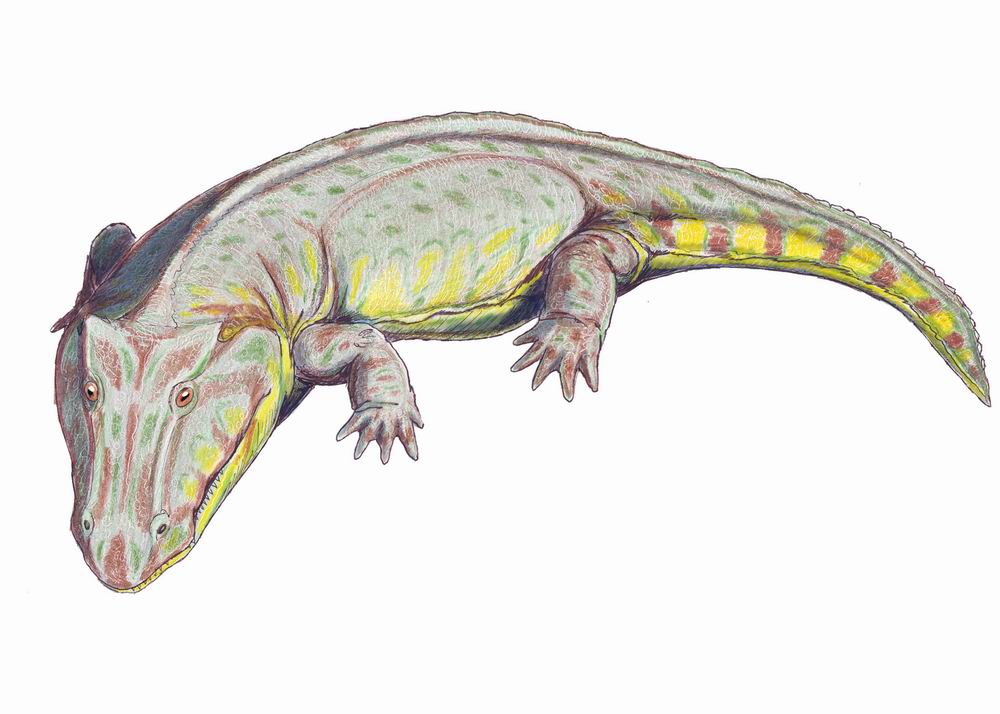
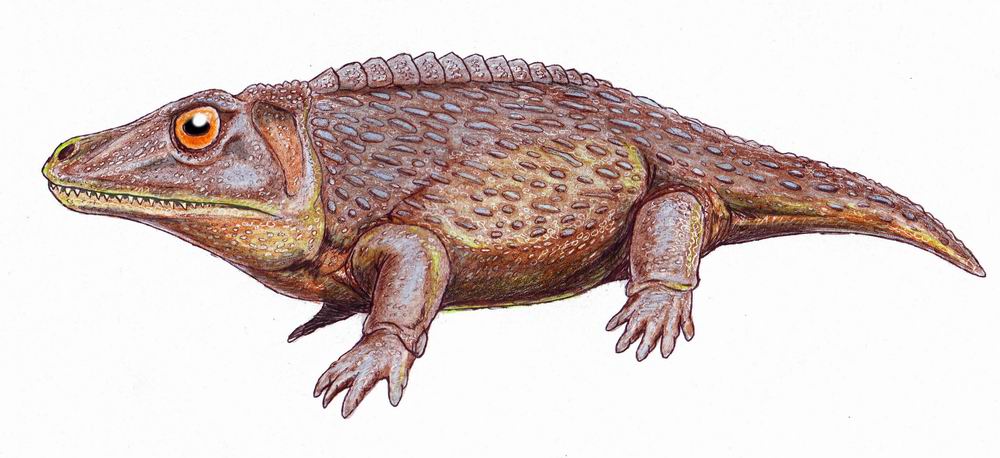
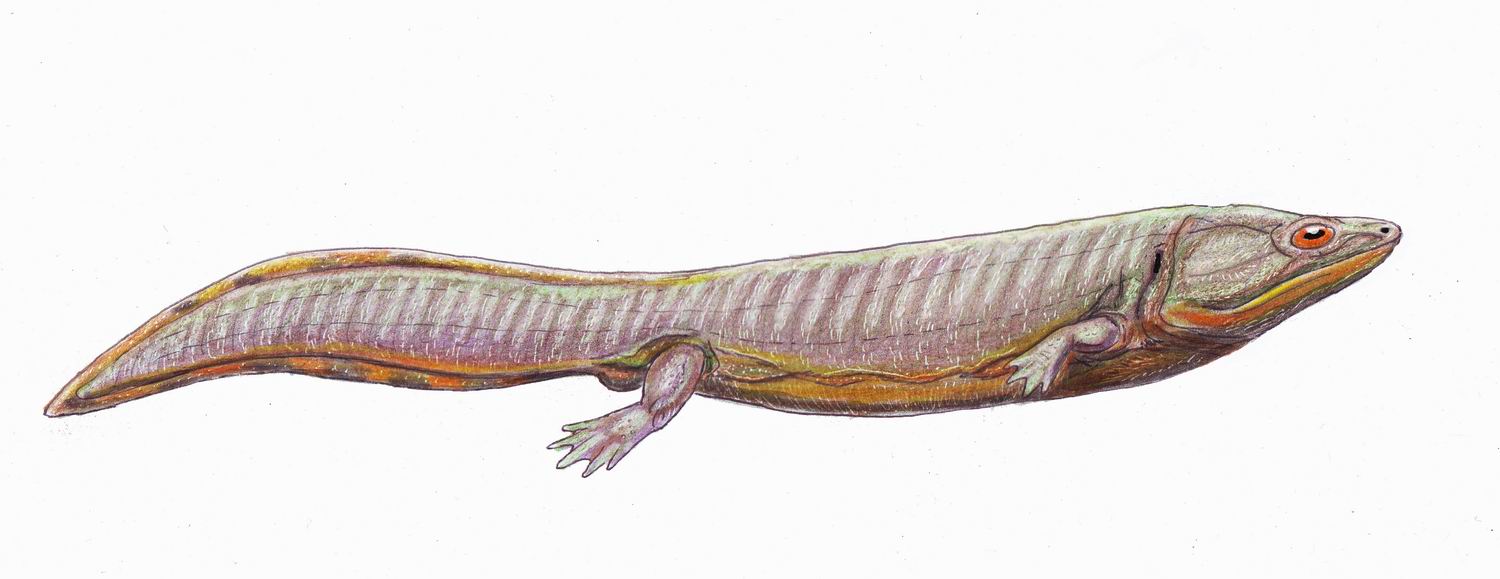
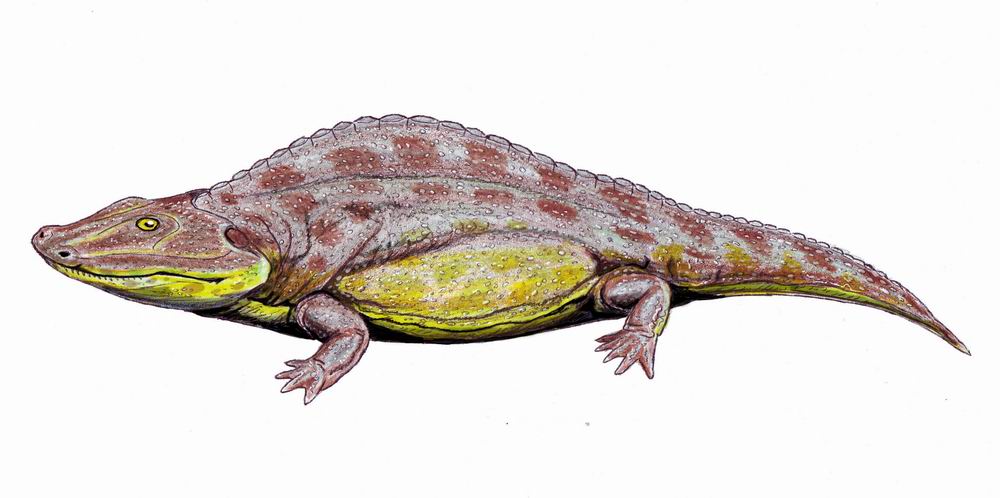
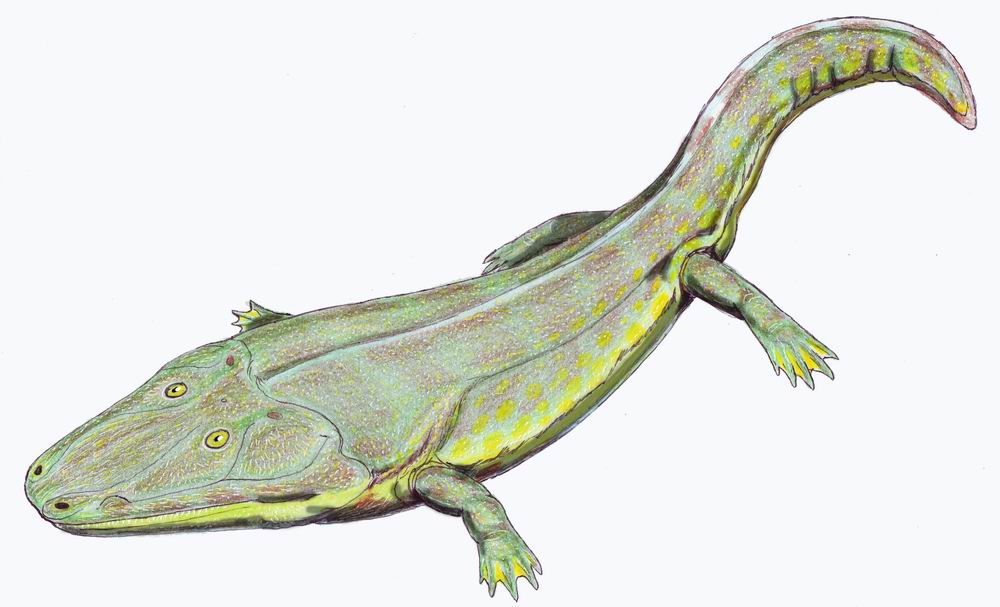
아래는 현재 알려진 그룹들을 보여주는 분추류의 간단한 분류이다:
양서강
- 분추목 (Order Temnospondyli)
- * 에돕스상과 (Superfamily Edopoidea)
- ** 에돕스과 (Family Edopidae)
- ** 코클레오사우루스과 (Family Cochleosauridae (케노프로소푸스과 Chenoprosopidae))
- * 덴드레페톤과 (Family Dendrerpetontidae)
- * 드비노사우리아아목 (Suborder Dvinosauria)
- * 에우스켈리아아목 (Suborder Euskelia)
- ** 디소로포이드상과 (Superfamily Dissoropoidea)
암피바미드과 (Family Amphibamidae)
브란키오사우리드과 (Family Branchiosauridae)
디소로피드과 (Family Dissorophidae)
미크로멜레르페톤티드과(Family Micromelerpetontidae)
- ** 에리오포이드상과(Superfamily Eryopoidea)
에리오피드과(Family Eryopidae)
파리옥시드과(Family Parioxyidae)
자트라키디드과(Family Zatrachydidae)
- * 림나르키아 (Clade Limnarchia)
- ** 고추형류 (Clade Stereospondylomorpha)
아르케고사우로이드상과 (Superfamily Archegosauroidea)
* 악티노돈티드과 (Family Actinodontidae)
* 아르케고사우리드과 (Family Archegosauridae)
* 인트라수키드과 (Family Intasuchidae - 위치는 불명확)
고추아목 (Suborder Stereospondyli)
* 펠토바크라이드과 (Family Peltobatrachidae)
* 라필롭시드과 (Family Lapillopsidae)
* 리네수키드과 (Family Rhinesuchidae)
* 리데케리니드과 (Family Lydekkerinidae)
* 카피토사우리아 (Clade Capitosauria)
** 마스토돈사우로이드상과 (Superfamily Mastodonsauroidea - 카피토사우로이드상과(Capitosauroidea))
*** 헤일레로사우리드과 (Family Heylerosauridae)
*** 마스토돈사우리드과 (Family Mastodonsauridae)
*** 스클레로토라키드과 (Family Sclerothoracidae)
* 트레마토사우리아하목 (Infraorder Trematosauria)
** 트레마토사우로이드상과 (Superfamily Trematosauroidea)
** 메토포사우로이드상과 (Superfamily Metoposauroidea)
** 플라기오사우로이드상과 (Superfamily Plagiosauroidea)
** 브라키오포이드상과 (Superfamily Brachyopoidea)
** 리티도스테오이드상과 (Superfamily Rhytidosteoidea)
1983년 가드너(Gardiner)는 분추류를 하나의 분지군으로 묶는 다섯 가지 파생공유형질을 제시했다. 여기에는 두개골 뒤쪽의 뼈인 부설상골(parasphenoid)이 두개골 아래쪽의 뼈인 접형골(pterygoid)과 연결되어 있다는 점, 접형골 사이에 간접형골공(interpterygoid vacuities)이라는 큰 구멍이 있다는 점, 등골(청각과 관련된 뼈, stapes)이 부설상골과 연결되어 있으며 위쪽으로 뻗어 있다는 점, 팔이음뼈의 일부인 클레이트룸(cleithrum)이 가늘다는 점, 그리고 간배연골(interdorsal)이라고 불리는 척추뼈의 일부가 신경궁(neural arch)과 연결되어 있다는 점이 포함된다.[275][187] 1987년 고드프리(Godfrey) 등은 두개골 뒤쪽에서 후두정골(postparietal)과 외후두골(exoccipital)이 만나는 점, 갈비뼈에 갈고리돌기(uncinate process)가 있는 점, 골반 양쪽의 장골에 각각 하나씩 날(blade)이 있는 것 등의 특징을 추가로 제시했다.[276][188]
계통발생학적 분석에서 분추류는 기반군(basal) 네발동물로 간주되지만, 정확한 위치는 연구에 따라 다르다.[277][189] 현생 양서류(Lissamphibia)의 분류에 따라 분추류는 상투군(crown group) 네발동물 또는 줄기군(stem group) 네발동물에 포함될 수 있다. 상투군 네발동물은 현생 네발동물의 가장 최근 공통 조상과 그 후손 전체를 포함하며, 줄기군 네발동물은 상투군 외부에 위치하는 네발동물이다. 최근 현생 양서류가 분추류의 후손이라는 가설이 제기되었는데, 이 경우 분추류는 상투군 네발동물이 된다. 루타(Ruta) 등이 2003년에 제시한 분석에서는 분추류를 상투군 네발동물 내에 위치시킨다.[278][190]
반면, 다른 연구에서는 현생 양서류를 공추류(Lepospondyli)의 후손으로 보고 분추류를 줄기군 네발동물 중 더 기저적인 위치에 놓는다. 로랭(Laurin)과 레이스(Reisz)의 1999년 연구는 분추류를 상투군 네발동물의 외부에 위치시킨다.[279][191]
분추목 내부 관계에 대한 최초의 광범위한 계통발생 연구 중 하나는 1990년 고생물학자 앤드류 밀너(Andrew Milner)에 의해 수행되었다.[280][192] 2007년 루타(Ruta) 등은 이전 연구들의 과 수준 분지도를 통합하여 분추목 전체의 "수퍼 트리(super tree)"를 제시했다.[281][193] 이 분석에 따르면, 가장 기저적인 그룹은 에돕스상과이며, 그 다음으로 덴드레페톤과, 드비노사우리아, 그리고 더 분화된 그룹들이 위치한다.
분추목의 가장 기저적인 그룹은 에돕스상과(Edopoidea)이다. 이들은 단일 후두골 융기나 다른 분추류에 없는 간측두골(intertemporal) 등 원시적인 특징(원시형질)을 가진다. 에돕스상과에는 석탄기 후기의 에돕스(Edops) 속과 코클레오사우루스과(Cochleosauridae)가 포함된다. 가장 오래된 분추목 과인 덴드레페톤과(Dendrerpetontidae)는 한때 에돕스상과에 포함되었으나, 최근 분석에서는 더 분화된 위치에 놓인다.[282][194][283][195] 발라네르페톤(Balanerpeton woodi)은 가장 오래된 종으로, 약 3억 3천만 년 전 석탄기 초기 비세절에 살았다. 카페투스(Capetus), 이베로스폰딜루스(Iberospondylus), 그리고 페름기 후기의 사하라스테가(Saharastega)와 니게르페톤(Nigerpeton) 등도 원시적인 분추류에 속한다. 특히 사하라스테가와 니게르페톤은 다른 기반군 분추류보다 약 4천만 년이나 젊어, 화석 기록에 아직 알려지지 않은 긴 가상계통(ghost lineage)의 존재를 시사한다.[284][196]
2000년 고생물학자 아담 예이츠(Adam Yates)와 앤 워렌(Anne Warren)은 더 분화된 분추류의 계통발생을 연구하며 새로운 분지군들을 명명했다.[274][186] 주요 분지군으로는 에우스켈리아(Euskelia)와 림나르키아(Limnarchia)가 있다. 에우스켈리아는 과거 라키토미로 불렸던 그룹으로, 디소로포이드상과(Dissorophoidea)와 에리오포이드상과(Eryopoidea)를 포함한다. 디소로포이드는 작고 주로 육상생활을 했으며, 현생 양서류의 조상일 가능성이 높은 그룹이다. 에리오포이드는 에리옵스(Eryops)와 같은 대형 분추류를 포함한다. 림나르키아는 대부분의 중생대 분추류와 일부 페름기 그룹을 포함하며, 아르케고사우로이드상과(Archegosauroidea)와 더 분화된 고추류(Stereospondyli)를 포함한다.[186] 예이츠와 워렌은 석탄기부터 트라이아스기까지 살았던 소형 수생 분추류 그룹인 드비노사우리아(Dvinosauria)도 명명했다.[274][186] 이들은 드비노사우리아를 림나르키아 내에 포함시켰으나, 후속 연구에서는 에우스켈리아보다 더 기저적인 위치[281][193] 또는 기저 림나르키아 위치[285][197] 등 다른 결과를 제시하기도 했다.
고추류(Stereospondyli) 내에서는 카피토사우리아(Capitosauria)와 트레마토사우리아(Trematosauria)라는 두 주요 분지군이 설정되었다.[186] 카피토사우리아는 마스토돈사우루스(Mastodonsaurus)와 같이 납작한 머리와 뒤쪽에 위치한 눈을 가진 대형 반수생 분추류를 포함한다. 트레마토사우리아는 대형 해양 트레마토사우로이드(Trematosauroidea), 수생 플라기오사우르(Plagiosaurus), 백악기까지 생존한 브라키오포이드(Brachyopoidea), 앞쪽에 눈이 위치한 메토포사우로이드(Metoposauroidea) 등 다양한 그룹을 포함한다. 2000년 쇼크(Schoch)와 밀너(Milner)는 고추류 내의 세 번째 주요 분지군으로 리티도스테아(Rhytidostea)를 제안했으나,[286][198] 최근 분석에서는 이 그룹이 단계통군이 아닌 것으로 나타나는 경우가 많다. 리티도스테이드과(Rhytidosteidae)와 브라키오포이드는 트레마토사우리아와 함께 묶이는 경향이 있으며, 리데케리니드과(Lydekkerinidae)는 원시적인 고추류 과로 간주된다.[287][199][288][200]
2013년 고생물학자 레이너 쇼크(Rainer Schoch)는 분추목의 새로운 계통발생 이론을 제시했다. 이 연구는 예이츠와 워렌이 제안한 많은 분지군을 지지했지만, 에우스켈리아와 림나르키아로의 구분은 지지하지 않았다. 에리오피드과(Eryopidae)는 디소로포이드보다 고추형류(Stereospondylomorpha)에 더 가까운 관계인 것으로 밝혀졌고, 디소로포이드는 드비노사우리아와 함께 묶였다. 에리오피드과와 고추형류를 포함하는 분지군은 에리오피형류(Eryopiformes)로 명명되었다. 또한 쇼크는 에돕스상과 외의 모든 분추류를 포함하는 분지군을 진분추류(Eutemnospondyli)로, 에돕스상과와 덴드레페톤과를 제외한 모든 분추류를 가리키는 분지군에 라키토미(Rhachitomi)라는 이름을 다시 부여했다. 아래는 쇼크의 분석에서 제시된 관계를 요약한 것이다.[289][1]
- 에돕스상과 (Edopoidea)
- 진분추류 (Eutemnospondyli)
- "덴드레페톤과" (Dendrerpetontidae)
- 라키토미 (Rhachitomi)
- 드비노사우리아 (Dvinosauria) + 자트라키디드과(Zatracheidae) + 디소로포이드상과(Dissorophoidea)
- 에리오피형류 (Eryopiformes)
- 에리오피드과 (Eryopidae)
- 고추형류 (Stereospondylomorpha) (더 분화된 그룹 포함)
현생 양서류(진양서류, Lissamphibia: 개구리, 도롱뇽, 무족영원류)의 기원에 대해서는 여러 가설이 존재한다. 분자 시계 추정에 따르면 첫 진양서류는 석탄기 후기에, 바트라키아(Batrachia: 개구리와 도롱뇽)는 페름기 중기에 나타난 것으로 보인다.[290][201][291][202] 화석 증거를 기반으로 한 주요 이론은 다음과 같다:
1. 진양서류가 공추류(Lepospondyli), 특히 리소로피아류(Lysorophia)에서 진화했다는 이론.[292][205]
2. 진양서류가 분추목, 특히 디소로포이드상과(Dissorophoidea)에서 진화했다는 이론.[203][204]
3. 무족영원류는 공추류에서, 개구리와 도롱뇽은 디소로포이드 분추류에서 각각 진화했다는 이론(다계통설).[293][206]
최근에는 분추류가 모든 진양서류의 조상이라는 이론(위의 2번 이론)이 널리 지지를 얻고 있다. 특히, 작고 유태보존(paedomorphic) 형태를 보이는 디소로포이드 분추류에서 발견되는 쌍두치(bicuspid) 형태의 자루모양 이빨(pedicellate teeth)이 진양서류와의 연관성을 시사하는 강력한 증거로 제시된다.[294][207] 이 이빨은 석회화된 끝부분과 기저부 사이에 석회화되지 않은 중간 부분이 있는 독특한 구조를 가지며, 이는 현생 양서류와 특정 분추목 화석 모두에서 관찰된다.[295][208]
디소로포이드상과 내의 암피바미드과(Amphibamidae)는 진양서류와 가장 가까운 관계인 것으로 여겨진다. 2008년 텍사스에서 발견된 게로바트라쿠스(Gerobatrachus hottoni)는 개구리 같은 머리와 도롱뇽 같은 몸을 가져 "개구롱뇽(frogamander)"이라는 별명을 얻었으며, 계통발생학적 분석에서 진양서류의 자매군으로 분류되었다. 그러나 돌레세르페톤(Doleserpeton annectens)이라는 다른 암피바미드가 진양서류와 더 가까운 관계일 수 있다는 주장도 있다. 1969년부터 알려진 돌레세르페톤은 자루모양 이빨 구조 때문에 일찍부터 현생 양서류의 근연종으로 여겨졌으며, "원시진양서류"로 불리기도 했다. 종명 "아넥텐스(annectens)"는 "연결한다"는 의미로, 분추류와 진양서류 사이의 중간 형태임을 시사한다.[294][207] 돌레세르페톤의 고막(tympanum) 구조는 개구리와 유사하며,[296][209][297][210] 입천장 구조, 두개골 뒤쪽 형태, 짧은 갈비뼈, 매끈한 두개골 표면 등 다른 특징들도 게로바트라쿠스보다 진양서류에 더 가깝다는 것을 보여준다. 시구르드센(Sigurdsen)과 볼트(Bolt)의 2010년 연구에서는 돌레세르페톤이 게로바트라쿠스보다 진양서류에 더 가까운 자매군으로 분석되었다.[298][211]
한편, 트라이아스기의 스테레오스폰딜로 추정되는 친레스테고피스(Chinlestegophis)는 현생 무족영원과 많은 특징을 공유하는 것으로 보고되었다. 만약 이것이 사실이라면, 모든 진양서류가 분추목에서 유래했을지라도, 무족영원류는 분추목 계통수의 다른 가지(스테레오스폰딜)에서, 개구리와 도롱뇽은 또 다른 가지(디소로포이드)에서 유래했을 가능성을 시사한다. 이 경우, 무미목과 유미목은 살아남은 디소로포이드 분추류의 후손이고, 무족목(무족영원류)은 살아남은 스테레오스폰딜의 후손이 될 수 있다.[212]
6. 고생물학
분추목은 고생대 후기부터 중생대 초기에 번성했던 양서류의 한 목으로, 현생 양서류보다 훨씬 크고 다양한 형태를 가졌다. 상당수 분추류는 겉모습이 악어와 비슷하여 학명에 '-suchus'라는 접미사가 붙는 경우가 많다. 특히 중생대의 입체두류(Stereospondyli) 중 일부는 두개골 길이가 1m를 넘고 전체 몸길이가 수 미터에 달했을 것으로 추정된다.[2][3][4][5] 반면, 양서목류(Amphibamiformes)나 마이크로멜레르페톤과(Micromelerpetidae)처럼 몸집이 작고 도롱뇽을 닮은 종류도 있었다.[6][206][237]
대부분 분추류는 넓고 납작한 머리를 가졌으며, 주둥이는 뭉툭하거나 길쭉했다. 두개골은 위에서 보았을 때 포물선 또는 삼각형 모양이며, 표면은 벌집 모양의 구멍과 돌기들로 덮여 있는 경우가 많다. 이 울퉁불퉁한 표면은 혈관이 지나가는 자리였을 수 있으며, 이산화탄소를 뼈로 운반하여 혈액의 산성화를 막는 데 도움을 주었을 가능성이 제기된다. 초기 반수생 네발동물은 육상에서 이산화탄소 배출에 어려움을 겪었을 수 있으며, 진피골이 이를 해결하는 초기 방식이었을 수 있다.[7][238] 하지만 다른 가설들도 존재하며[8], 현생 양서류에는 이 특징이 없어 정확한 기능은 아직 불분명하다.[9][10][11][12][13][14] 많은 분추류는 두개골에 감각구(sulcus)라는 홈을 가지고 있는데, 이는 물 속 진동을 감지하는 측선 시스템의 일부로, 수생 생활의 증거로 여겨진다.[18][19][20][21][237] 일부 육상형 분추류는 콧등 끝에 점액선을 수용했을 것으로 보이는 구멍(internarial fenestra)을 가지기도 했다.[28]
분추류의 두개골 뼈는 대부분 다른 초기 네발동물과 상동 관계에 있지만, 일부 분추류 분류군에서는 간비골(internasal), 간전두골(interfrontal), 간두정골(interparietal)과 같은 독특한 뼈가 발달하기도 했다.[32][33][34][35][237] 두개골 뒤쪽에는 이개절(otic notch)이라는 함몰부가 있는 경우가 많은데, 이는 고막이 부착되는 자리로 추정되지만[40][41][42][43][44][45], 모든 분추류에서 같은 기능을 했는지는 불확실하며 일부 분류군(플라기오사우루스과, 브라키오피드과)에는 아예 없다.[32][46][47] 분추류 두개골의 가장 큰 특징 중 하나는 입천장 뒤쪽에 있는 한 쌍의 큰 구멍인 간익상골 공극(interpterygoid vacuity)이다.[48][49][50] 이 구멍은 추가적인 근육 부착 공간을 제공하고, 먹이를 삼킬 때 안구를 뒤로 당기는 데 사용되었을 수 있다.[51][52] 분추류는 턱뿐만 아니라 입천장에도 이빨이 많았으며, 일부는 매우 큰 엄니 형태를 띠었다.[53][54] 니게르페톤 같은 종은 아래턱의 엄니가 입천장을 뚫고 두개골 위쪽 구멍으로 솟아나기도 했다.[4][57][58][241]
분추류의 연조직에 대한 정보는 드물지만, 석탄기 펜실베이니아기 마우치 청크 층(Mauch Chunk Formation)에서 발견된 몸 자국 화석은 이들이 매끈한 피부, 가는 다리와 물갈퀴가 있는 발, 몸 아래쪽의 주름진 피부를 가졌음을 보여준다.[242] 석탄기와 페름기 지층에서 발견되는 흔적화석인 바트라크이크누스(*Batrachichnus*)는 작은 분추류가 남긴 것으로 추정되며, 주로 담수 환경 퇴적층에서 발견되어 이들이 물가 근처에서 생활했음을 시사한다.[243]
많은 분추류는 현생 양서류와 달리 작고 촘촘한 비늘로 덮여 있었으며, 특히 배 쪽은 크고 넓은 배판(ventral plates)으로 보호되었다. 이 배판은 개체 발생 초기의 작은 비늘들이 성장하면서 발달한 것으로 보이며, 서로 겹쳐져 있어 어느 정도 유연성을 제공했다.[95] 후기의 반수생 분추류(트레마토사우루스류, 카피토사우루스류)에서는 비늘의 증거가 없는데, 이는 물속 이동을 용이하게 하거나 피부호흡을 하기 위해 퇴화했을 가능성이 있다.[95][244]
일부 분추류 그룹은 등 쪽에 단단한 골판(osteoderm) 갑옷을 가지고 있었다. 펠토바트라쿠스(*Peltobatrachus*)는 등과 배 양쪽이 모두 갑옷으로 덮여 있었고[96][245], 리티도스테과(Rhytidosteidae)의 라이들레리아(*Laidleria*)도 등에 넓은 골판을 가졌다. 디소로피드과(Dissorophidae) 동물 대부분은 등 중앙선을 따라 두 줄의 좁은 골판을 가졌으며[97][98][99][100][246], 에리옵스(*Eryops*) 같은 종은 피부 속에 박혀 있었을 작은 원반 모양의 골편(scute)을 가지고 있었다. 이러한 갑옷은 주로 육상 생활에 적응한 분추류에서 발견되며, 포식자 방어[96][245]나 척추 안정성[103][247] 등의 기능을 했을 것으로 추정된다. 수생 분추류인 플라기오사우르류에서도 골판이 발견되는데, 이는 육상 조상으로부터 물려받은 형질이거나[96][245], 미네랄 저장고 역할을 했을 가능성이 제기된다.[104]
분추류의 척추는 여러 부분으로 나뉘는 것이 특징이다. 현생 네발동물의 척추뼈 몸통(centrum)은 하나의 뼈이지만, 분추류는 플루로센트룸(pleurocentrum)과 인터센트룸(intercentrum)이라는 두 부분으로 구성된다. 크게 두 가지 형태가 있는데, 라키토무스형(rhachitomous) 척추는 큰 쐐기 모양의 인터센트룸과 작은 플루로센트룸으로 이루어져 비교적 튼튼하며 육상 생활에 적합했다. 반면, 스테레오스폰딜형(stereospondylous) 척추는 플루로센트룸이 퇴화하고 인터센트룸이 주된 척추 몸통을 이루어 상대적으로 약하며, 주로 수생 분추류에서 나타난다.[59][249] 이 외에도 플라기오사우루스형, 투필라코사우루스형(이중척추형) 등 다양한 척추 형태가 존재했다.[60][61][62][63][64][65][66][67] 스클레로토락스(*Sclerothorax*)나 에리옵스처럼 부분적으로 육상 생활을 한 분추류는 척추뼈 위에 긴 신경배돌기(neural spine)를 가져 척추 안정성을 높였다.[248] 디소로피드인 플라티히스트릭스(*Platyhystrix*)는 매우 긴 신경배돌기가 등에서 큰 돛 모양을 이루기도 했다.[71][72]
대부분의 분추류는 앞발에 4개, 뒷발에 5개의 발가락을 가졌지만[234], 최근 연구에서 메토포사우루스처럼 앞발가락이 5개인 경우도 확인되었다.[89][90][91][235] 육상 분추류는 수생 분추류보다 더 크고 튼튼한 다리를 가졌으며, 일부는 발톱도 있었다.[239] 특이한 육상 분추류인 파옐라(*Fayella*)는 몸통에 비해 다리가 길어, 먹이를 쫓아 빠르게 달렸을 가능성이 있다.[240]
현생 양서류(진양서류, Lissamphibia)의 기원에 대해서는 여러 가설이 있지만, 최근에는 분추류, 특히 디소로포이드상과(Dissorophoidea)에서 진화했다는 이론이 널리 지지받고 있다.[293] 주요 증거 중 하나는 쌍두치(bicuspid) 형태의 자루모양 이빨(pedicellate teeth)인데, 이는 이빨의 끝부분과 기저부만 석회화되고 중간은 석회화되지 않는 독특한 구조로, 현생 양서류와 일부 디소로포이드 분추류에서 공통적으로 나타난다.[206][28][207][55][56][211][294][295] 디소로포이드 중 암피바미드과(Amphibamidae)는 진양서류와 가장 가까운 관계인 것으로 여겨진다. 2008년 텍사스에서 발견된 게로바트라쿠스(*Gerobatrachus hottoni*)는 머리는 개구리 같고 몸은 도롱뇽 같아 "개구롱뇽(frogamander)"이라는 별명을 얻었으며, 진양서류의 자매분류군으로 간주된다.[298] 암피바미드과의 돌레세르페톤(*Doleserpeton annectens*)은 게로바트라쿠스보다 더 진양서류에 가까운 특징(자루모양 이빨, 고막 구조, 입천장 모양 등)을 보여, 분추류와 진양서류를 잇는 중요한 연결고리로 여겨진다.[294][296][297][298]
분추류의 생활 방식은 다양했다. 대부분은 반수생이었지만, 일부는 육상 생활에, 다른 일부는 완전 수생 생활에 적응했다. 이들의 섭식, 생식, 성장 방식 등은 하위 문단에서 더 자세히 다룬다.
완전 수생 분추류인 아케고사우루스(*Archegosaurus*)에 대한 연구는 이들의 열 균형, 가스 교환, 삼투압 조절 등이 현생 수생 양서류보다는 어류와 더 유사했음을 시사한다.[213]
6. 1. 섭식
초기 분추목은 주로 반수생 생활을 했지만, 육지에서도 먹이를 찾을 수 있는 능력을 가지고 있었다.[214] 시간이 지나면서 일부는 육상 생활에 더 잘 적응했고(예: 에리오포이드류, 디소로포이드), 다른 일부는 수중 생활에 더욱 특화되었다. 페름기의 아르케고사우리아류는 주로 물속에서 먹이를 찾는 최초의 분추목이었으며, 이후 트레마토사우리아와 카피토사우리아도 독립적으로 수중 생활 방식과 섭식으로 돌아섰다.[299][214] 육상 생활에 적응한 분추류, 예를 들어 디소로포이드인 포네르페톤(Phonerpeton)은 육상 먹이를 물어뜯는 데 적합한 두개골 구조를 가졌다. 이들의 두개골 뼈 사이 봉합선은 먹이를 물 때 발생하는 강한 압축력을 견딜 수 있도록 발달했다.[218][303] 이는 물속에서 흡입 섭식을 할 때 인장력을 견뎌야 했던 초기 수생 네발동물이나 조상들과는 다른 특징이다. 포네르페톤과 같은 분추류는 거의 완전히 육상 생활을 하며 물어서 먹이를 잡는 방식으로 진화한 최초의 네발동물 중 하나로 여겨진다.[219][304]반면, 대부분의 수생 분추목(특히 스테레오스폰딜)은 납작한 머리를 가졌다. 이들은 먹이를 먹을 때 아래턱을 아래로 내리는 대신, 두개골 자체를 뒤쪽으로 들어 올려 입을 벌렸을 것으로 추정된다. 이러한 방식은 플라기오사우루스과에 속하는 게로토락스(Gerrothorax)에서 잘 연구되었는데, 게로토락스는 목의 첫 번째 뼈인 환추와 머리뼈 뒤쪽의 후두골 관절융기 사이의 관절을 이용해 두개골을 수평선 위로 약 50도까지 들어 올릴 수 있었다. 이 과정에서 네모뼈(방형골)가 앞으로 밀리면서 아래턱이 바깥쪽으로 튀어나가는 독특한 움직임을 보였다.[215][300] 다른 수생 분추목들도 비슷한 방식으로 두개골을 들어 올렸을 가능성이 있지만, 게로토락스만큼 특화되지는 않았을 수 있다. 분추목이 두개골을 들어 올려 먹이를 먹었을 것이라는 아이디어는 D.M.S. 왓슨(D.M.S. Watson)이 처음 제안했으며, 그는 게로토락스보다 훨씬 컸던 마스토돈사우루스(Mastodonsaurus) 역시 같은 방식으로 섭식했을 것이라고 보았다.[301][216][217][302] 이후 1959년, 고생물학자 A.L. 판첸(A.L. Panchen) 역시 바트라코수쿠스(Batrachosuchus)가 이러한 방식으로 먹이를 먹었을 것이라고 주장하며 왓슨의 견해를 지지했다.[245][96] 초기에는 강력한 턱 근육이 이 움직임을 가능하게 했을 것으로 생각했지만, 현재는 목과 어깨뼈(가슴띠)에 연결된 더 큰 근육을 사용했을 것으로 보고 있다. 게로토락스의 가까운 친척인 플라기오수쿠스(Plagiosuchus)는 매우 작은 이빨과 두개골 뒤쪽에 넓은 근육 부착 자국을 가지고 있어, 입을 빠르게 벌려 물과 함께 먹이를 빨아들이는 흡입 섭식을 했을 가능성이 제기된다. 플라기오수쿠스는 또한 근육 부착에 사용되었을 수 있는 설골(아가미와 혀를 지지하는 뼈) 구조를 가지고 있었다.[175][268]
6. 2. 생식
대부분의 분추류는 현생 양서류와 마찬가지로 물 속에서 번식했으며, 체외수정을 통해 번식했을 것으로 추정된다. 암컷이 물 속에 알 덩어리를 낳으면 수컷이 그 위에 정자를 뿌려 수정시키는 방식은 현생 개구리와 유사했을 것이다.1998년 미국 텍사스의 페름기 초기 지층에서 발견된 화석은 디소로포이드 분추류의 알 덩어리로 추정되는데, 이는 최초로 발견된 양서류 알 화석일 가능성이 있다. 이 화석은 난황막으로 보이는 얇은 막을 가진 작은 원반 형태이며, 주변에는 점액질 막이 둘러싸고 있다. 알들이 식물 화석에 붙어 있는 모습은 이들이 현생 개구리처럼 수중 식물에 알을 낳았음을 시사한다. 점액질 막은 이 알이 어류가 아닌 양서류의 것임을 보여주는 증거이지만(어류 알에는 점액질이 없음), 정확히 어떤 종류의 분추류인지는 알 수 없다. 다만, 발견된 지층에서 가장 흔한 양서류가 디소로포이드이고, 이들이 현생 양서류와 가까운 관계이며 유사한 생식 방식을 가졌을 것으로 추정되기 때문에 디소로포이드의 알일 가능성이 높게 여겨진다.[220]
드비노사우리아 분추류인 트리메로라키스(Trimerorhachis)의 경우, 아가미 사이 공간인 인두낭(pharyngeal pouch)에서 새끼를 길렀을 가능성이 제기되었다. 어린 트리메로라키스 개체의 뼈가 이 공간에서 발견되었기 때문이다. 만약 이것이 사실이라면, 입 안에서 올챙이를 키우는 현생 다윈의 개구리와 유사한 방식이었을 수 있다. 하지만 다른 가능성으로는, 트리메로라키스가 오늘날 많은 양서류처럼 어린 개체를 잡아먹는 동족포식을 했을 수도 있다는 것이다. 이 경우, 인두낭에서 발견된 작은 뼈들은 원래 식도에 있다가 화석화 과정에서 밀려났을 수 있다.[221]
한편, 일부 육상 분추류는 물 밖에서 짝짓기를 했을 가능성도 있다. 미국 펜실베이니아에서 발견된 석탄기 전기 분추류의 몸통 자국 화석은 이들이 체내수정을 통해 번식했음을 시사한다. 하나의 사암 덩어리에 세 마리의 개체가 함께 발견된 것은 이들이 군집 생활을 했을 가능성을 보여주며, 한 개체의 머리가 다른 개체의 꼬리 아래에 놓인 자세는 구애 행동의 일부였을 수 있다.[222] 이러한 체내수정과 구애 행동은 현생 도롱뇽에게서도 관찰된다.[223]
6. 3. 성장
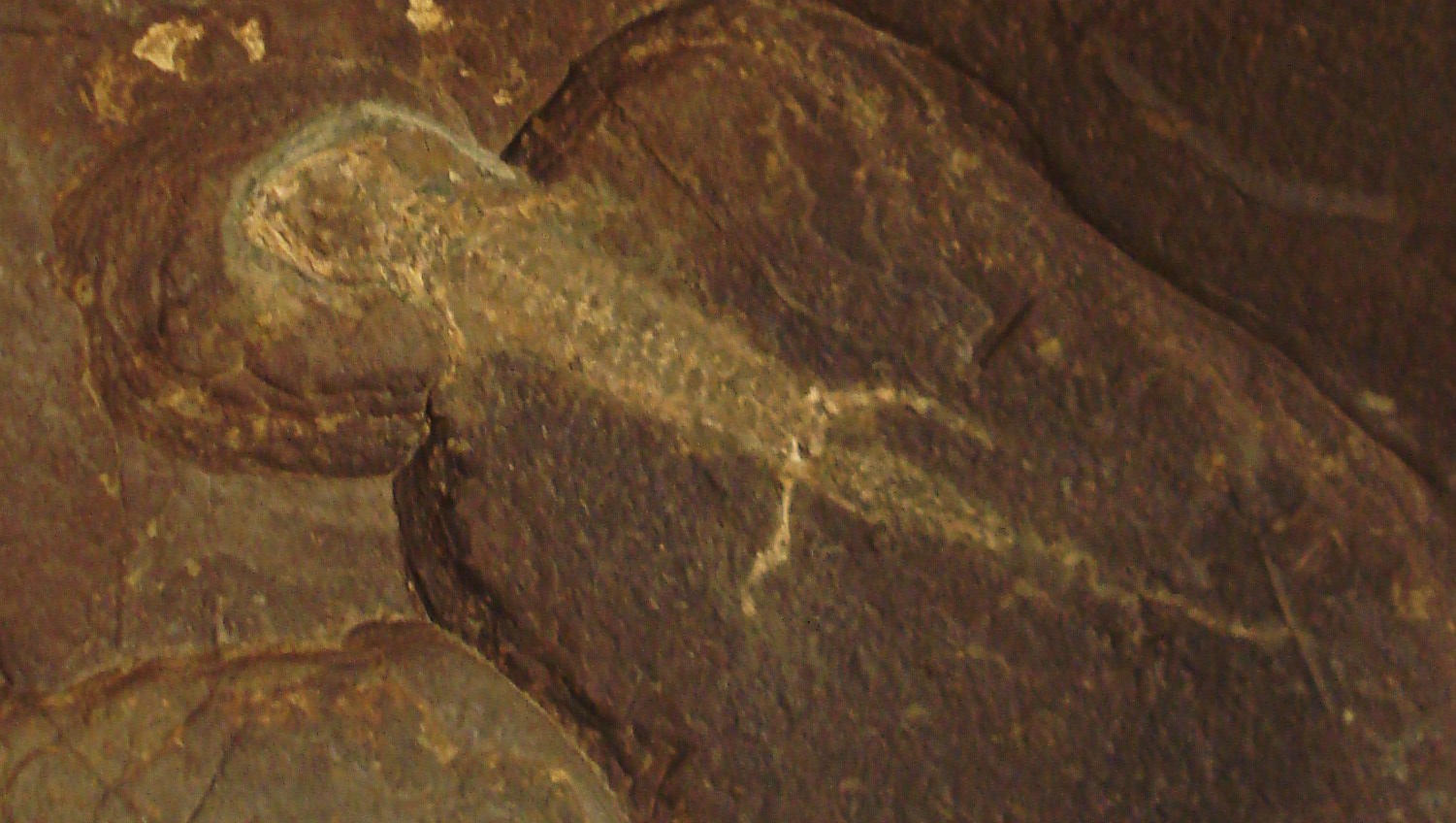
대부분의 분추류는 성체의 특징으로 구분되지만, 일부는 어린 개체나 유생 단계의 표본으로만 알려져 있다. 디소로포이드, 에리오피드, 자트라키디드 등은 수중 생활을 하는 유생에서 육상 생활이 가능한 성체로 변태하는 과정을 거쳤다.[308][224] 그러나 브란키오사우리드과와 같은 일부 디소로포이드는 완전한 변태를 거치지 않고, 아가미나 작은 몸집 같은 유생 시기의 특징을 성체가 되어서도 유지했는데, 이를 유태보존(neoteny)이라고 한다.[308][224] 드비노사우리아와 플라기오사우루스류인 게로토락스 역시 아가미를 유지하는 유태보존 현상을 보였으나,[309][225] 최근 연구에 따르면 이들의 아가미는 (적어도 성체에서는) 도롱뇽처럼 외부에 있는 것이 아니라 물고기처럼 내부에 있는 아가미였을 가능성이 제기되었다.[226]
분추류 유생은 일반적으로 뼈가 덜 발달했으며, 살아있을 때 아가미가 붙어 있던 일련의 뼈인 아가미설골(hyobranchial apparatus)을 가지고 있다는 점으로 구별된다. 하지만 완전히 성장한 일부 분추류도 아가미설골을 가지고 있었지만, 외부 아가미는 없었다.[310][227] 몸을 촘촘히 덮는 비늘은 유생과 성체 모두에게서 발견되는 특징이다. 변태 과정에서는 두개골 모양이 변하고 단단해지며, 몸의 뼈들이 두꺼워지고 몸집이 커지는 등 큰 신체적 변화가 일어난다.[227]
스클레로케팔루스와 같은 분추류는 큰 성체 표본과 작은 유생 표본이 모두 발견되어, 성장 과정에서 몸 형태가 크게 변하는 것을 보여준다. 이 종들은 발달 초기 단계에서 두개골의 모양과 비율이 변하며, 두개골 표면의 장식(작은 구멍에서 큰 이랑으로)도 이 시기에 발달한다. 성장하면서 외부 아가미는 사라지고, 입천장을 덮고 있던 작은 이빨들도 없어진다. 몸통 골격은 두개골보다 느리게 골질화(연골이 뼈로 변하는 과정)가 진행된다.[310][227] 척추뼈와 다리뼈는 발달이 더뎌서 초기 단계에는 갈비뼈와 발가락뼈가 없고, 견갑돌기(어깨뼈 복합체)와 좌골(골반뼈의 일부)은 발달 후반에야 나타난다.[311][228] 성장이 완료되면 대부분의 뼈가 형성되고 성장 속도는 느려진다. 두투이토사우루스 같은 일부 분추류의 뼈에는 성장 흔적이 남아 있는데, 이는 계절 변화에 따라 성장률이 달랐음을 시사할 수 있다.[312][229] 메토포사우루스나 켈리데르페톤 같은 분추류 화석은 개체가 성적으로 성숙한 이후에도 계속 성장했음을 보여준다. 나이가 많은 개체일수록 두개골의 구멍이 더 많고 깊게 파여 있는 경향이 있다.[313][230]
분추류의 한 갈래인 브란키오사우리드과 역시 유생 표본으로 잘 알려져 있다. 브란키오사우루스나 아파테온 같은 브란키오사우리드과는 피부와 외부 아가미가 보존된 화석이 많다. 다양한 크기의 표본을 통해 전체 개체발생 과정을 추적할 수 있지만, 육상 생활에 적응한 성체 형태가 발견되지 않아 이들이 유태보존 상태였을 것으로 추정되었다. 다른 분추류와 달리 이들의 몸통 골격은 성체가 되어서도 부분적으로 연골 상태를 유지했으며, 성체도 유생처럼 수중 생활을 했을 가능성이 높다. 그러나 최근 육상 생활에 적응한 특징을 보이는 큰 아파테온 그라킬리스(''Apateon gracilis'') 표본이 보고되어, 모든 브란키오사우리드가 유태보존 형태는 아니었음을 시사한다.[310][227]
분추류 발달 연구에서 아가미를 가진 종들이 어떤 형태의 아가미를 가졌는지에 대한 논쟁이 있었다. 일부 종은 연조직으로 보존된 외부 아가미를 가졌지만, 많은 경우 아가미 뼈 구조를 통해 추론해야 했다. 과학자들은 이 뼈 구조가 내부 아가미를 시사하는지(물고기와의 비교) 또는 외부 아가미를 시사하는지(도롱뇽과의 비교)에 대해 의견이 갈렸는데, 이를 'Bystrow의 역설'이라고 한다.[226] 2010년 연구는 홈이 있는 각새궁(ceratobranchial, 아가미활의 구성 요소) 구조가 내부 아가미와 관련이 있음을 밝혀 이 역설을 해결하는 데 기여했다. 이 연구에 따르면, 드비노사우루스 ''Dvinosaurus''와 같이 홈이 있는 각새궁을 가진 고대 네발동물은 성체로서 내부 아가미만을 가졌을 가능성이 높다. 외부 아가미는 유생이나 브란키오사우리드과 같은 특화된 그룹에서만 확인되었다. 현생 폐어 중 하나인 남아메리카폐어(''Lepidosiren'')는 유생 시기에는 외부 아가미를, 성체 시기에는 내부 아가미를 가지는데, 드비노사우루스류의 아가미 발달도 이와 유사했을 수 있다 (비록 수렴 진화의 결과일 가능성이 높지만). 따라서 완전히 수생이며 아가미를 가진 분추류(드비노사우루스류 포함)는 유생 시기에는 외부 아가미를, 성체 시기에는 내부 아가미를 가졌을 것으로 결론지을 수 있다.[226]
대부분의 분추류가 어릴 때 수중 생활을 한 반면, 대부분의 메토포사우루스과는 유생 단계에서 육상 생활을 했을 것으로 보인다. 다른 중생대 분추류처럼 성체 메토포사우루스과는 반수생 생활에 적응했다. 성체의 뼈는 땅 위에서 움직이기에는 충분히 발달하지 않았으며, 특히 다리뼈 단면 두께는 육상 이동의 압력을 견디기 어려웠을 것으로 보인다. 반면, 유생 개체는 상대적으로 뼈가 더 두꺼워 육상에서 움직일 수 있었을 것이다. 육상 생활을 유지하려면 분추류의 다리뼈가 몸의 다른 부분보다 더 빠르게 자라는 양의 상대성장(positive allometry)을 보여야 하는데, 메토포사우루스과는 그렇지 않았기 때문에 몸집이 커질수록 육상 생활에 부적합해졌을 것이다.[314][231]
참조
[1]
논문
The evolution of major temnospondyl clades: An inclusive phylogenetic analysis
2013
[2]
논문
The last Labyrinthodont? A new brachyopoid (Amphibia, Temnospondyli) from the early Jurassic Evergreen formation of Queensland, Australia
http://dx.doi.org/10[...]
1983-09-13
[3]
논문
Fishes and amphibians from the Late Permian Pedra de Fogo Formation of northern Brazil
https://www.palass.o[...]
1991
[4]
서적
Comparative osteology of Mastodonsaurus giganteus (Jaeger, 1828) from the Middle Triassic (Lettenkeuper: Longobardian) of Germany (Baden-Württemberg, Bayern, Thüringen)
http://worldcat.org/[...]
Staatl. Museum für Naturkunde
1999
[5]
논문
A giant brachyopoid temnospondyl from the Upper Triassic or Lower Jurassic of Lesotho
http://dx.doi.org/10[...]
2005-05-01
[6]
논문
The amphibamid Micropholis from the Lystrosaurus Assemblage Zone of South africa
http://www.tandfonli[...]
2005-09-30
[7]
논문
Dermal bone in early tetrapods: a palaeophysiological hypothesis of adaptation for terrestrial acidosis
2012-08-07
[8]
논문
The functional morphology of dermal bone ornamentation in temnospondyl amphibians
2013
[9]
논문
MORPHOLOGISCHE UNTERSUCHUNGEN DER DECKKNOCHEN DESSCHÄDELS DER WIRBELTIERE
https://onlinelibrar[...]
1935
[10]
서적
Review of the labyrinthodontia
https://search.world[...]
1947
[11]
논문
Possible functions of ornament in labyrinthodont amphibians
1974
[12]
논문
Can metamorphosis be recognised in Palaeozoic amphibians ?
http://www.schweizer[...]
2001-06-11
[13]
논문
Comparative histology of sculptured dermal bones in basal tetrapods, and the implications for the soft tissue dermis
http://www.palaeodiv[...]
2009-12-30
[14]
논문
Sculpture and vascularization of dermal bones, and the implications for the physiology of basal tetrapods
http://dx.doi.org/10[...]
2010-07-26
[15]
논문
The Lapillopsidae: a new family of small temnospondyls from the Early Triassic of Australia
http://dx.doi.org/10[...]
1999-06-14
[16]
논문
Phylogenetic reappraisal of Rhytidosteidae (Stereospondyli: Trematosauria), temnospondyl amphibians from the Permian and Triassic
http://dx.doi.org/10[...]
2011
[17]
논문
Skull morphology and phylogenetic relationships of a new Middle Triassic plagiosaurid temnospondyl from Germany, and the evolution of plagiosaurid eyes
2014-02-26
[18]
논문
A Contribution to a Monograph of the Extinct Amphibia of North America. New Forms from the Carboniferous
1909
[19]
서적
On the dermal skulls of Lyrocephalus, Aphaneramma, and Benthosaurus, Labyrinthodonts from the triassic of Spitzbergen and N. Russia
http://worldcat.org/[...]
"[publisher not identified]"
1937
[20]
논문
A theory of the relations of lateral lines to dermal bones.
1949
[21]
논문
The Aquatic Origin of Tetrapods
https://www.jstor.or[...]
1960
[22]
간행물
Lateral-Line Mechano-Receptors in Fishes and Amphibians
https://doi.org/10.1[...]
Springer
2022-03-20
[23]
간행물
Amphibian Lateral Line Receptors
https://doi.org/10.1[...]
Springer
2022-03-20
[24]
논문
The evolution of the amphibian lateral line system and its bearing on amphibian phylogeny
2009-04-27
[25]
서적
The Mechanosensory Lateral Line
Springer
1989
[26]
논문
Development and evolution of lateral line placodes in amphibians I. Development
http://dx.doi.org/10[...]
2002
[27]
논문
Evolution of posterior lateral line development in fish and amphibians
https://onlinelibrar[...]
2004
[28]
간행물
8. A Phylogenetic Investigation of the Inter- and Intrarelationships of the Lissamphibia (Amphibia: Temnospondyli)
http://dx.doi.org/10[...]
Cornell University Press
2022-03-20
[29]
서적
Permian amphibians from New Mexico, by Wann Langston ...
https://www.worldcat[...]
University of California Press
1953
[30]
논문
A Lower Permian temnospondylous amphibian from the English Midlands
https://www.palass.o[...]
1975
[31]
논문
Cranial anatomy of the Permian temnospondyl amphibian Zatrachys serratus Cope 1878, and the phylogenetic position of the Zatrachydidae
http://dx.doi.org/10[...]
1997-11-14
[32]
논문
A phylogeny of the Brachyopoidea (Temnospondyli, Stereospondyli)
http://dx.doi.org/10[...]
2000-09-25
[33]
논문
Revision of the Aquatic Eryopid Temnospondyl Glaukerpeton avinoffi Romer, 1952, from the Upper Pennsyl Vanian of North America
http://www.bioone.or[...]
2012
[34]
논문
A new find of Trematosuchus (Amphibia, Temnospondyli) from the Cynognathus zone of South Africa
https://www.research[...]
1994
[35]
논문
Cranial morphology of the plagiosaurid Gerrothorax pulcherrimus as an extreme example of evolutionary stasis
http://dx.doi.org/10[...]
2011-10-13
[36]
논문
A Small Temnospondyl Amphibian from the Lower Pennsylvanian of Nova Scotia
https://www.jstor.or[...]
1982
[37]
논문
A cochleosaurid temnospondyl amphibian from the Middle Pennsylvanian of Linton, Ohio, U.S.A.
https://doi.org/10.1[...]
1998-01-01
[38]
논문
The vertebrate fauna of the Upper Permian of Niger. V. The primitive temnospondylSaharastega moradiensis
http://dx.doi.org/10[...]
2006-09-11
[39]
논문
The vertebrate fauna of the Upper Permian of Niger. IV. Nigerpeton ricqlesi (Temnospondyli: Cochleosauridae), and the Edopoid Colonization of Gondwana
https://www.tandfonl[...]
2006-03-30
[40]
논문
Evolution of the amphibian tympanic ear and the origin of frogs
http://dx.doi.org/10[...]
1985
[41]
논문
The first articulated skeleton ofDendrerpeton acadianum(Temnospondyli, Dendrerpetontidae) from the Lower Pennsylvanian locality of Joggins, Nova Scotia, and a review of its relationships
http://dx.doi.org/10[...]
1998-04-10
[42]
논문
The braincase and middle ear region of Dendrerpeton acadianum (Tetrapoda: Temnospondyli)
2005
[43]
논문
The otic region ofDoleserpeton(Temnospondyli) and its implications for the evolutionary origin of frogs
2008
[44]
간행물
Amphibia: A Case of Diversity and Convergence in the Auditory Region
http://dx.doi.org/10[...]
Springer International Publishing
2022-03-20
[45]
논문
The stapes ofEdops craigiand ear evolution in the lissamphibian stem group
http://dx.doi.org/10[...]
2017-12-27
[46]
논문
The oldest stegocephalian from the Iberian Peninsula: evidence that temnospondyls were euryhaline
http://dx.doi.org/10[...]
2001
[47]
논문
Exceptional endocranium and middle ear of Stanocephalosaurus (Temnospondyli: Capitosauria) from the Triassic of Algeria revealed by micro-CT scan, with new functional interpretations of the hearing system
http://dx.doi.org/10[...]
2017-01-20
[48]
논문
Palate anatomy and morphofunctional aspects of interpterygoid vacuities in temnospondyl cranial evolution
http://dx.doi.org/10[...]
2016-09-14
[49]
논문
The Palatal Interpterygoid Vacuities of Temnospondyls and the Implications for the Associated Eye- and Jaw Musculature
2017-03-03
[50]
논문
Evolutionary changes in the orbits and palatal openings of early tetrapods, with emphasis on temnospondyls
http://dx.doi.org/10[...]
2018
[51]
논문
Contribution of eye retraction to swallowing performance in the northern leopard frog, Rana pipiens
2004-03-15
[52]
논문
Eye Movements in Frogs and Salamanders—Testing the Palatal Buccal Pump Hypothesis
https://doi.org/10.1[...]
2019-01-01
[53]
논문
The mandibles of the Triassic temnospondyl amphibians
http://dx.doi.org/10[...]
1986
[54]
논문
Folded teeth in temnospondyls — a preliminary study
http://dx.doi.org/10[...]
1992
[55]
논문
The Paleozoic Relatives of Lissamphibians
https://www.jstor.or[...]
1993
[56]
논문
Morphology and systematics of the Pennsylvanian amphibian Platyrhinops lyelli (Amphibia: Temnospondyli)
http://dx.doi.org/10[...]
2009
[57]
논문
The amphibian Erpetosaurus radiatus (Temnospondyli, Dvinosauria) from the Middle Pennsylvanian of Linton, Ohio: morphology and systematic position
https://www.palass.o[...]
2011
[58]
논문
The South African stereospondylMicroposaurusfrom the Middle Triassic of the Sydney Basin, Australia
http://dx.doi.org/10[...]
2012
[59]
서적
Evolution of the Vertebrates
https://archive.org/[...]
John Wiley & Sons
1969
[60]
논문
The Homologies of the Labyrinthodont Centrum
https://www.jstor.or[...]
1967
[61]
논문
Triassic Australian Plagiosauroid
https://www.jstor.or[...]
1985
[62]
논문
The postcranial skeleton of Mesozoic temnospondyl amphibians: a review
http://dx.doi.org/10[...]
1991
[63]
논문
Congenital Malformations of the Vertebral Column in Ancient Amphibians
http://dx.doi.org/10[...]
2013-04-03
[64]
논문
Vertebral Development in Paleozoic and Mesozoic Tetrapods Revealed by Paleohistological Data
2016-04-13
[65]
논문
Karoo tupilakosaurid: A relict from Gondwana
http://dx.doi.org/10[...]
1998
[66]
논문
The earliest tupilakosaurid amphibian with diplospondylous vertebrae from the Late Permian of southern France
http://dx.doi.org/10[...]
2007-03-12
[67]
논문
Tupilakosaur-like vertebrae in Bothriceps australis , an Australian brachyopid stereospondyl
http://www.tandfonli[...]
2011
[68]
논문
A description of the vertebral column of Eryops, based on the notes and drawings of A.S. Romer
https://www.biodiver[...]
1974
[69]
논문
An intriguing temnospondyl skeleton from the Lower Triassic of Germany
http://dx.doi.org/10[...]
2004-07-09
[70]
논문
Anatomy and relationships of the Triassic temnospondyl Sclerothorax
https://agro.icm.edu[...]
2007
[71]
논문
Early Permian vertebrates from the Culter Formation of the Placerville area, Colorado, with a section on footprints from the Cutler Formation
1965
[72]
논문
Skull of the Lower Permian dissorophid amphibian Platyhystrix rugosus
https://www.research[...]
1981
[73]
논문
A Platyhystrix-like Amphibian with Fused Vertebrae, from the Upper Pennsylvanian of Ohio
https://www.jstor.or[...]
1971
[74]
논문
Histological evidence for dermal-endochondral co-ossification of the dorsal blades in the late Paleozoic amphibian Platyhystrix rugosus (Temnospondyli: Dissorophidae)
https://www.tandfonl[...]
2022-08-31
[75]
서적
Bulletin of the Museum of Comparative Zoology
https://www.biodiver[...]
1964
[76]
논문
Ichthycanthus platypus Cope, 1877, Reidentified as the Dissorophoid Amphibian Amphibamus lyelli
https://www.jstor.or[...]
1984
[77]
논문
Neldasaurus wrightae, a new rhachitomous labyrinthodont from the Texas Lower Permian
https://www.biodiver[...]
1965
[78]
서적
Athlon. Essays on Palaeontology in Honour of Loris Shano Russell
Royal Ontario Museum
[79]
논문
The postcranial skeleton of ''Trimerorhachis insignis'' Cope, 1878 (Temnospondyli: Trimerorhachidae): a plesiomorphic temnospondyl from the Lower Permian of North America
[80]
서적
Handbook of Paleoherpetology Part 3A2. Temnospondyli I
https://www.worldcat[...]
Verlag Dr. Friedrich Pfeil
2014
[81]
논문
The postcranial skeleton of Mesozoic temnospondyl amphibians: a review
http://www.tandfonli[...]
1991-01
[82]
논문
To be or not to be heavier: The role of dermal bones in the buoyancy of the Late Triassic temnospondyl amphibian Metoposaurus krasiejowensis
2022-12
[83]
논문
A Terrestrial Stereospondyl from the Lower Triassic of South Africa: The Postcranial Skeleton of Lydekkerina Huxleyi (Amphibia: Temnospondyli)
2005
[84]
논문
The Postcranium of Archegosaurus Decheni, and a Phylogenetic Analysis of Temnospondyl Postcrania
2006
[85]
논문
The Appendicular Skeleton of Eryops Megacephalus Cope, 1877 (Temnospondyli: Eryopoidea) from the Lower Permian of North America
http://dx.doi.org/10[...]
2006
[86]
논문
The lissamphibian humerus and elbow joint, and the origins of modern amphibians
http://dx.doi.org/10[...]
2009
[87]
논문
''Fayella chickashaensis'', the Dissorophoidea and the Permian terrestrial radiations
[88]
논문
Large dissorophoid skeletal elements from the Lower Permian Richards Spur Fissures, Oklahoma, and their paleoecological implications
http://dx.doi.org/10[...]
2000-09-25
[89]
서적
Bulletin of the British Museum (Natural History) Geology
https://www.biodiver[...]
British Museum of Natural History
1956
[90]
논문
Carpus and tarsus of Temnospondyli
https://journals.lib[...]
2015-10-22
[91]
논문
Pentadactyl manus of the Metoposaurus krasiejowensis from the Late Triassic of Poland, the first record of pentadactyly among Temnospondyli
http://dx.doi.org/10[...]
2020-07-24
[92]
논문
Aspects of the Biology of Trimerorhachis (Amphibia: Temnospondyli)
https://www.jstor.or[...]
1979
[93]
논문
On the squamation of Australerpeton cosgriffi Barberena, a temnospondyl amphibian from the Upper Permian of Brazil
2002
[94]
논문
Morphological and histological changes of dermal scales during the fish-to-tetrapod transition
http://dx.doi.org/10[...]
2010-06-29
[95]
논문
The evolution of the scalation pattern in temnospondyl amphibians
[96]
논문
A new armoured amphibian from the Upper Permian of East Africa
[97]
서적
The phylogenetic and functional implications of the armor of the Dissorophidae
https://www.biodiver[...]
Field Museum of Natural History
1966
[98]
논문
Armor of dissorophids (Amphibia: Labyrinthodontia): an examination of its taxonomic use and report of a new occurrence
[99]
논문
Comparison and biomechanical interpretations of the vertebrae and osteoderms of Cacops aspidephorus and Dissorophus multicinctus (Temnospondyli, Dissorophidae)
http://dx.doi.org/10[...]
2009-12-12
[100]
논문
Dissorophid diversity at the early Permian cave system near Richards Spur, Oklahoma, USA
2019
[101]
서적
Ecolsonia cutlerensis, an Early Permian dissorophid amphibian from the Cutler Formation of north-central New Mexico
http://worldcat.org/[...]
New Mexico Bureau of Mines & Mineral Resources
1985
[102]
논문
A new genus and species of trematopid amphibian from the Late Pennsylvanian of north-central New Mexico
http://dx.doi.org/10[...]
1987-09-16
[103]
논문
Comparison and biomechanical interpretations of the vertebrae and osteoderms of ''Cacops aspidephorus'' and ''Dissorophus multicinctus'' (Temnospondyli, Dissorophidae)
[104]
논문
The bone histology of osteoderms in temnospondyl amphibians and in the chroniosuchianBystrowiella
http://dx.doi.org/10[...]
2010
[105]
논문
The origin and early radiation of terrestrial vertebrates
http://dx.doi.org/10[...]
2001
[106]
논문
Early amphibians evolved distinct vertebrae for habitat invasions
2021-06-09
[107]
논문
The Alimentary Canal of a Carboniferous Salamander
http://dx.doi.org/10[...]
1910
[108]
논문
Timeless design: colored pattern of skin in early Permian branchiosaurids (Temnospondyli: Dissorophoidea)
http://dx.doi.org/10[...]
2007-12-12
[109]
논문
Limb ossification in the Paleozoic branchiosaurid Apateon (Temnospondyli) and the early evolution of preaxial dominance in tetrapod limb development
http://dx.doi.org/10[...]
2007-01-12
[110]
논문
The Permotriassic branchiosaurid ''Tungussogyrinus'' Efremov, 1939 (Temnospondyli, Dissorophoidea) from Siberia restudied
2009-08-01
[111]
논문
Lissamphibian-like toepads in an exceptionally preserved amphibamiform from Mazon Creek
http://dx.doi.org/10[...]
2019-11-02
[112]
논문
A new chigutisaurid (Brachyopoidea, Temnospondyli) with soft tissue preservation from the Triassic Sydney Basin, New South Wales, Australia
2023-08-03
[113]
논문
The Smallest Known Tetrapod Footprints:Batrachichnus Salamandroidesfrom the Carboniferous of Joggins, Nova Scotia, Canada
http://dx.doi.org/10[...]
2012
[114]
논문
A revision of tetrapod footprints from the late Carboniferous of the West Midlands, UK
2016-11-24
[115]
논문
A Temnospondyl Trackway from the Early Mesozoic of Western Gondwana and Its Implications for Basal Tetrapod Locomotion
2014-08-06
[116]
논문
Transition between terrestrial-submerged walking and swimming revealed by Early Permian amphibian trackways and a new proposal for the nomenclature of compound trace fossils
http://dx.doi.org/10[...]
2014
[117]
논문
Middle Triassic (Ladinian) amphibian tracks from the Lower Keuper succession of southern Germany: Implications for temnospondyl locomotion and track preservation
http://dx.doi.org/10[...]
2020
[118]
논문
Small Footprints Expand Middle Permian Amphibian Diversity in the South African Karoo
http://dx.doi.org/10[...]
2020-01-06
[119]
서적
Über die fossile reptilien, welche in Würtemberg aufgefunden worden sind
J.B. Metzler
[120]
논문
Proceedings of Learned Societies: Geological Society
https://www.biodiver[...]
[121]
논문
Revision of the type material and nomenclature of ''Mastodonsaurus giganteus'' (Jaeger) (Temnospondyli) from the Middle Triassic of Germany
[122]
논문
Report on British fossil reptiles
https://books.google[...]
[123]
서적
Palaeontology or A systematic summary of extinct animals and their geological relations
Adam and Charles Black
[124]
논문
Postcranial remains of ''Baphetes'' and their bearing on the relationships of the Baphetidae (= Loxommatidae)
[125]
논문
''Rhombopholis'', a prolacertiform reptile from the Middle Triassic of England
http://palaeontology[...]
[126]
서적
Outlines of vertebrate palaeontology for students of zoology
University Press
[127]
논문
A contribution to a monograph of the extinct amphibia of North America. New forms from the Carboniferous
[128]
서적
The Fossil Book: A Record of Prehistoric Life
https://archive.org/[...]
Courier Corporation
[129]
서적
Systematic summary of extinct animals and their geological relations
Adam and Charles Black
[130]
서적
The Order Microsauria
https://books.google[...]
[131]
논문
Studies for Students: The Development and Geological Relations of the Vertebrates
[132]
논문
Handbuch der Palæontologie of Zittel
[133]
논문
Review of the Labyrinthodontia
https://archive.org/[...]
[134]
논문
The Structure, Evolution and Origin of the Amphibia. The "Orders" Rachitomi and Stereospondyli
[135]
논문
Tetrapod Phylogeny, Amphibian Origins, and the Definition of the Name Tetrapoda
http://dx.doi.org/10[...]
2002-03-01
[136]
논문
Phylogeny of Paleozoic limbed vertebrates reassessed through revision and expansion of the largest published relevant data matrix
2019-01-04
[137]
논문
A review of the fossil record of caecilians (Lissamphibia: Gymnophionomorpha) with comments on its use to calibrate molecular timetrees
https://doi.org/10.1[...]
2020-11-03
[138]
논문
A Triassic stem-salamander from Kyrgyzstan and the origin of salamanders
2020-05-26
[139]
논문
Triassic stem caecilian supports dissorophoid origin of living amphibians
http://dx.doi.org/10[...]
2023-01-25
[140]
논문
The new problem of Chinlestegophis and the origin of caecilians (Amphibia, Gymnophionomorpha) is highly sensitive to old problems of sampling and character construction
http://dx.doi.org/10[...]
2024-05-28
[141]
논문
A phylogeny of the Brachyopoidea (Temnospondyli, Stereospondyli)
http://www.tandfonli[...]
2000-09-25
[142]
논문
A systematic revision and phylogenetic analysis of Triassic mastodonsauroids (Temnospondyli: Stereospondyli)
http://dx.doi.org/10[...]
2001-12-01
[143]
논문
Phylogenetic reappraisal of Rhytidosteidae (Stereospondyli: Trematosauria), temnospondyl amphibians from the Permian and Triassic
http://dx.doi.org/10[...]
2011-06-01
[144]
논문
The cranial morphology of the temnospondylAustralerpeton cosgriffi(Tetrapoda: Stereospondyli) from the Middle-Late Permian of Paraná Basin and the phylogenetic relationships of Rhinesuchidae
https://doi.org/10.1[...]
2015-10-15
[145]
논문
The putative lissamphibian stem-group: phylogeny and evolution of the dissorophoid temnospondyls
2019-01-01
[146]
논문
Geometric Morphometrics of the Skull Roof of Stereospondyls (Amphibia: Temnospondyli)
http://dx.doi.org/10[...]
2006-03-01
[147]
논문
The Roots of Amphibian Morphospace: A Geometric Morphometric Analysis of Paleozoic Temnospondyls
http://dx.doi.org/10[...]
2012-10-18
[148]
논문
Morphospace occupation of temnospondyl growth series: a geometric morphometric approach
http://dx.doi.org/10[...]
2009-09-01
[149]
논문
Morphological evolution of the skull roof in temnospondyl amphibians mirrors conservative ontogenetic patterns
https://doi.org/10.1[...]
2019-08-12
[150]
논문
Temnospondyli bite club: ecomorphological patterns of the most diverse group of early tetrapods
http://dx.doi.org/10[...]
2011-06-24
[151]
논문
Multi-Joint Analysis of Pose Viability Supports the Possibility of Salamander-Like Hindlimb Configurations in the Permian TetrapodEryops megacephalus
https://doi.org/10.1[...]
2022-06-10
[152]
논문
Triassic Amphibian from Antarctica
https://www.science.[...]
1968-08-02
[153]
논문
A giant brachyopoid temnospondyl from the Upper Triassic or Lower Jurassic of Lesotho
http://dx.doi.org/10[...]
2005-05-01
[154]
논문
The first temnospondyl amphibian from Japan
http://www.tandfonli[...]
2011-09-01
[155]
논문
Oldest known stereospondylous amphibian from the Early Permian of Namibia
http://dx.doi.org/10[...]
2001-03-26
[156]
논문
A presumed stereospondyl (Amphibia, Stereospondyli) from the marine Triassic of Titiroa Stream, Mataura valley, Southland, New Zealand
http://dx.doi.org/10[...]
2003-03-01
[157]
논문
First occurrence of temnospondyls from the Permian and Triassic of Turkey: Paleoenvironmental and paleobiogeographic implications
http://dx.doi.org/10[...]
2015-06-01
[158]
논문
No gap in the Middle Permian record of terrestrial vertebrates: REPLY
2013
[159]
논문
Permian tetrapod extinction events
http://dx.doi.org/10[...]
2017
[160]
논문
The temnospondyl amphibians from the Viséan of East Kirkton, West Lothian, Scotland
http://dx.doi.org/10[...]
1993
[161]
논문
The oldest known tetrapod (Temnospondyli) from Germany (Early Carboniferous, Viséan)
2019-02-28
[162]
논문
New Permian fauna from tropical Gondwana
http://dx.doi.org/10[...]
2015-11-05
[163]
논문
Interrelationships, palaeobiogeography and early evolution of Stereospondylomorpha (Tetrapoda: Temnospondyli)
http://dx.doi.org/10[...]
2019-04-16
[164]
논문
A new stereospondylomorph, Korkonterpeton kalnense gen. et sp. nov., from lower Permian of the Czech Krkonoše Piedmont Basin and a redescription of Intasuchus silvicola from the lower Permian of Russia (Temnospondyli, Amphibia)
2020
[165]
논문
A review of the Guadalupian (middle Permian) global tetrapod fossil record
2017
[166]
논문
Olson's Gap or Olson's Extinction? A Bayesian tip-dating approach to resolving stratigraphic uncertainty
http://dx.doi.org/10[...]
2020-06-10
[167]
논문
Temnospondyls from the Beaufort Group (Karoo Basin) of South Africa and Their Biostratigraphy
https://www.scienced[...]
2004-01-01
[168]
논문
Biostratigraphy of the Tapinocephalus Assemblage Zone (Beaufort Group, Karoo Supergroup), South Africa
https://doi.org/10.2[...]
2020-06-01
[169]
논문
Biostratigraphy of the Eodicynodon Assemblage Zone (Beaufort Group, Karoo Supergroup), South Africa
https://doi.org/10.2[...]
2020-06-01
[170]
논문
A new Permian temnospondyl with Russian affinities from South America, the new family Konzhukoviidae, and the phylogenetic status of Archegosauroidea
https://www.tandfonl[...]
2017-03-04
[171]
논문
Osteology of the large dissorophid temnospondyl Anakamacops petrolicus from the Guadalupian Dashankou Fauna of China
https://www.tandfonl[...]
2018-09-03
[172]
논문
Fishes and amphibians from the Late Permian Pedra de Fogo Formation of Northern Brazil
http://palaeontology[...]
[173]
논문
The Rhinesuchidae and early history of the Stereospondyli (Amphibia: Temnospondyli) at the end of the Palaeozoic
http://dx.doi.org/10[...]
2017-05-29
[174]
문서
[175]
논문
The plagiosaurid temnospondyl ''Plagiosuchus pustuliferus'' (Amphibia: Temnospondyli) from the Middle Triassic of Germany: anatomy and functional morphology of the skull
[176]
논문
Labyrinthodont amphibians from Antarctica
[177]
논문
A new Triassic temnospondyl from Antarctica and a review of Fremouw Formation biostratigraphy
[178]
논문
Taphonomy of the Lamy amphibian quarry: A Late Triassic bonebed in New Mexico, U.S.A
http://libres.uncg.e[...]
[179]
논문
A new species ofMetoposaurusfrom the Late Triassic of Portugal and comments on the systematics and biogeography of metoposaurid temnospondyls
http://dx.doi.org/10[...]
2015-03-23
[180]
논문
Osteology, variability, and evolution of Metoposaurus, a temnospondyl from the Late Triassic of Poland
[181]
논문
Mortality dynamics and fossilisation pathways of a new metoposaurid-dominated multitaxic bonebed from India: a window into the Late Triassic vertebrate palaeoecosystem
https://www.tandfonl[...]
2021-10-03
[182]
논문
A relict trematosauroid (Amphibia: Temnospondyli) from the Middle Jurassic of the Junggar Basin (NW China)
https://doi.org/10.1[...]
2004-12-01
[183]
논문
Temnospondyl amphibians from the Jurassic of the Southern Junggar Basin (NW China)
https://doi.org/10.1[...]
2005-06-01
[184]
논문
Dinosaur burrows in the Otway Group (Albian) of Victoria, Australia, and their relation to Cretaceous polar environments
http://www.envs.emor[...]
[185]
웹사이트
Phylogeny and Apomorphies of Temnospondyls
http://tolweb.org/tr[...]
2011-07-18
[186]
논문
The phylogeny of the 'higher' temnospondyls (Vertebrata: Choanata) and its implications for the monophyly and origins of the Stereospondyli
[187]
논문
Gnathostome vertebrae and the classification of the Amphibia
[188]
논문
A newly discovered skull of the temnospondyl amphibian ''Dendrerpeton acadianum'' Owen
[189]
논문
A supertree of early tetrapods
[190]
논문
Early tetrapod relationships revisited
http://pondside.uchi[...]
2011-08-04
[191]
논문
A new study of ''Solenodonsaurus janenschi'', and a reconsideration of amniote origins and stegocephalian evolution
http://www.erin.utor[...]
[192]
서적
Major Evolutionary Radiations
Clarendon Press
[193]
논문
A supertree of Temnospondyli: cladogenetic patterns in the most species-rich group of early tetrapods
[194]
논문
The temnospondyl amphibian ''Dendrerpeton'' from the Upper Carboniferous of Ireland
http://palaeontology[...]
[195]
논문
The first articulated skeleton of ''Dendrerpeton acadianum'' (Temnospondyli: Dendrerpentonidae) from the Lower Pennsylvanian locality of Joggins, Nova Scotia, and a review of its relationships
[196]
논문
Permian tetrapods from the Sahara show climate-controlled endemism in Pangaea
http://www.burkemuse[...]
2011-08-04
[197]
논문
A redescription of ''Acroplous vorax'' (Temnospondyli: Dvinosauria) based on new specimens from the Early Permian of Nebraska and Kansas, U.S.A
[198]
서적
Handbuch der Paläoherpetologie Part 3B. Stereospondyli
Verlag Dr. Friedrich Pfeil
[199]
논문
A phylogeny of the Brachyopoidea
[200]
논문
A new tiny rhytidosteid (Temnospondyli: Stereospondyli) from the Early Triassic of Australia and the possibility of hidden temnospondyl diversity
[201]
논문
Mitogenomic perspectives on the origin and phylogeny of living amphibians
[202]
논문
Phylogeny of caecilian amphibians (Gymnophiona) based on complete mitochondrial genomes and nuclear RAG1
http://www.bmnh.org/[...]
[203]
서적
Vertebrate Palaeontology
https://books.google[...]
Wiley
2015-06-23
[204]
서적
Herpetology: An Introductory Biology of Amphibians and Reptiles
https://books.google[...]
Academic Press
2015-06-23
[205]
논문
The importance of global parsimony and historical bias in understanding tetrapod evolution. Part I — systematics, middle ear evolution, and jaw suspension
[206]
논문
A stem batrachian from the Early Permian of Texas and the origin of frogs and salamanders
http://www.cnah.org/[...]
[207]
논문
Lissamphibian origins: possible protolissamphibian from the Lower Permian of Oklahoma
[208]
논문
Pedicellate teeth and the problems of amphibian phylogeny
[209]
논문
Evolution of the amphibian tympanic ear and the origin of frogs
[210]
논문
The otic region of ''Doleserpeton'' (Temnospondyli) and its implications for the evolutionary origin of frogs
[211]
논문
The Lower Permian amphibamid ''Doleserpeton'' (Temnospondyli: Dissorophoidea), the interrelationships of amphibamids, and the origin of modern amphibians
[212]
논문
Stem caecilian from the Triassic of Colorado sheds light on the origins of Lissamphibia
2017-07-03
[213]
논문
Modeling the physiology of the aquatic temnospondyl Archegosaurus decheni from the early Permian of Germany
[214]
논문
Temnospondyli bite club: ecomorphological patterns of the most diverse group of early tetrapods
[215]
논문
''Gerrothorax pulcherrimus'' from the Upper Triassic Fleming Fjord Formation of East Greenland and a reassessment of head lifting in temnospondyl feeding
[216]
논문
The structure, evolution and origin of the Amphibia. The "Orders" Rachitomi and Stereospondyli
[217]
웹사이트
The flip-up skull of ''Gerrothorax''
http://www.hmnh.org/[...]
2011-08-02
[218]
논문
Feeding shifts across the fish-amphibian transition are revealed by changes in cranial sutural morphology
[219]
논문
Terrestrial-style feeding in a very early aquatic tetrapod is supported by evidence from experimental analysis of suture morphology
[220]
논문
Amphibian eggs from the Lower Permian of north-central Texas
[221]
논문
Aspects of the biology of ''Trimerorhachis'' (Amphibia: Temnospondyli)
[222]
논문
Amphibian body impressions from the Mississippian Mauch Chunk Formation, eastern Pennsylvania
[223]
웹사이트
Ancient Amphibians Left Full-Body Imprints
https://www.geosocie[...]
The Geological Society of America
2011-08-02
[224]
논문
The evolution of metamorphosis in temnospondyls
[225]
논문
The phylogeny of amphibian metamorphosis
http://users.humbold[...]
[226]
논문
Bystrow's Paradox - gills, fossils, and the fish-to-tetrapod transition
2011-07-01
[227]
논문
Metamorphosis and neoteny: alternative pathways in an extinct amphibian clade
[228]
논문
Early larval ontogeny of the Permo-Carboniferous temnospondyl Sclerocephalus
[229]
논문
First histological and skeletochronological data on temnospondyl growth: palaeoecological and palaeoclimatological implications
[230]
논문
Revision of ''Cheliderpeton vranyi'' Fritsch, 1877 (Amphibia, Temnospondyli) from the Lower Permian of Bohemia (Czech Republic)
[231]
논문
Limb allometry and lateral line groove development indicates terrestrial-to-aquatic lifestyle transition in Metoposauridae (Amphibia: Temnospondyli)
[232]
논문
Evolution of the tetrapod ear: an analysis and reinterpretation
[233]
웹사이트
Localities of the Carboniferous: ''Dendrerpeton'' and Joggins, Nova Scotia
http://www.ucmp.berk[...]
Regents of the University of California
2011-08-01
[234]
논문
Carpus and tarsus of Temnospondyli
https://journals.lib[...]
2014
[235]
논문
Pentadactyl manus of the Metoposaurus krasiejowensis from the Late Triassic of Poland, the first record of pentadactyly among Temnospondyli
https://onlinelibrar[...]
2020
[236]
논문
Bystrow’s Paradox – gills, fossils, and the fish-to-tetrapod transition
https://onlinelibrar[...]
2011
[237]
웹인용
Temnospondyli
http://tolweb.org/Te[...]
2011-08-03
[238]
저널
Dermal bone in early tetrapods: A palaeophysiological hypothesis of adaptation for terrestrial acidosis
[239]
저널
A new amphibamid (Amphibia: Temnospondyli) from the Late Pennsylvanian (Middle Stephanian) of central New Mexico, USA
[240]
저널
''Fayella chickashaensis'', the Dissorophoidea and the Permian terrestrial radiations
[241]
저널
The vertebrate fauna of the Upper Permian of Niger. IV. ''Nigerpeton ricqlesi'' (Temnospondyli: Cochleosauridae), and the edopoid colonization of Gondwana
http://www.washingto[...]
2014-04-03
[242]
웹인용
Ancient Amphibians Left Full-Body Imprints
http://www.geosociet[...]
The Geological Society of America
2011-08-02
[243]
서적
Pennsylvanian Footprints in the Black Warrior Basin of Alabama
Alabama Paleontological Society
[244]
저널
The evolution of the scalation pattern in temnospondyl amphibians
[245]
저널
A new armoured amphibian from the Upper Permian of East Africa
[246]
저널
Armor of dissorophids (Amphibia: Labyrinthodontia): an examination of its taxonomic use and report of a new occurrence
[247]
저널
Comparison and biomechanical interpretations of the vertebrae and osteoderms of ''Cacops aspidephorus'' and ''Dissorophus multicinctus'' (Temnospondyli, Dissorophidae)
[248]
저널
Anatomy and relationships of the Triassic temnospondyl ''Sclerothorax''
http://app.pan.pl/ar[...]
[249]
서적
Evolution of the Vertebrates
John Wiley & Sons
[250]
서적
Über die fossile reptilien, welche in Würtemberg aufgefunden worden sind
J.B. Metzler
[251]
저널
Proceedings of Learned Societies: Geological Society
http://www.biodivers[...]
[252]
저널
Revision of the type material and nomenclature of ''Mastodonsaurus giganteus'' (Jaeger) (Temnospondyli) from the Middle Triassic of Germany
[253]
저널
Report on British fossil reptiles
http://books.google.[...]
[254]
서적
Palaeontology or A systematic summary of extinct animals and their geological relations
Adam and Charles Black
[255]
저널
Postcranial remains of ''Baphetes'' and their bearing on the relationships of the Baphetidae (= Loxommatidae)
[256]
저널
"Rhombopholis, a prolacertiform reptile from the Middle Triassic of England"
http://palaeontology[...]
2011-08-04
[257]
서적
Outlines of vertebrate palaeontology for students of zoology
University Press
[258]
저널
A contribution to a monograph of the extinct amphibia of North America. New forms from the Carboniferous
[259]
서적
Systematic summary of extinct animals and their geological relations
Adam and Charles Black
[260]
저널
The Order Microsauria
http://books.google.[...]
[261]
저널
Studies for Students: The Development and Geological Relations of the Vertebrates
[262]
저널
Handbuch der Palæontologie of Zittel
[263]
저널
Review of the Labyrinthodontia
http://ia700303.us.a[...]
[264]
저널
The Structure, Evolution and Origin of the Amphibia. The "Orders" Rachitomi and Stereospondyli
[265]
저널
The postcranial skeleton of ''Trimerorhachis insignis'' Cope, 1878 (Temnospondyli: Trimerorhachidae): a plesiomorphic temnospondyl from the Lower Permian of North America
[266]
저널
Fishes and amphibians from the Late Permian Pedra de Fogo Formation of Northern Brazil
http://palaeontology[...]
2012-06-09
[267]
문서
[268]
저널
The plagiosaurid temnospondyl ''Plagiosuchus pustuliferus'' (Amphibia: Temnospondyli) from the Middle Triassic of Germany: anatomy and functional morphology of the skull
[269]
저널
Labyrinthodont amphibians from Antarctica
http://digitallibrar[...]
2014-04-10
[270]
저널
A new Triassic temnospondyl from Antarctica and a review of Fremouw Formation biostratigraphy
[271]
저널
Taphonomy of the Lamy amphibian quarry: A Late Triassic bonebed in New Mexico, U.S.A
[272]
저널
Dinosaur burrows in the Otway Group (Albian) of Victoria, Australia, and their relation to Cretaceous polar environments
http://www.envs.emor[...]
2011-08-04
[273]
웹인용
Phylogeny and Apomorphies of Temnospondyls
http://tolweb.org/tr[...]
2011-07-18
[274]
저널
The phylogeny of the 'higher' temnospondyls (Vertebrata: Choanata) and its implications for the monophyly and origins of the Stereospondyli
[275]
저널
Gnathostome vertebrae and the classification of the Amphibia
[276]
저널
A newly discovered skull of the temnospondyl amphibian ''Dendrerpeton acadianum'' Owen
[277]
저널
A supertree of early tetrapods
http://rspb.royalsoc[...]
[278]
저널
Early tetrapod relationships revisited
http://pondside.uchi[...]
2014-04-14
[279]
저널
A new study of ''Solenodonsaurus janenschi'', and a reconsideration of amniote origins and stegocephalian evolution
http://www.erin.utor[...]
[280]
서적
Major Evolutionary Radiations
Clarendon Press
[281]
저널
A supertree of Temnospondyli: cladogenetic patterns in the most species-rich group of early tetrapods
[282]
저널
The temnospondyl amphibian ''Dendrerpeton'' from the Upper Carboniferous of Ireland
http://palaeontology[...]
2011-07-16
[283]
저널
The first articulated skeleton of ''Dendrerpeton acadianum'' (Temnospondyli: Dendrerpentonidae) from the Lower Pennsylvanian locality of Joggins, Nova Scotia, and a review of its relationships
[284]
저널
tetrapods from the Sahara show climate-controlled endemism in Pangaea
http://www.burkemuse[...]
[285]
저널
A redescription of ''Acroplous vorax'' (Temnospondyli: Dvinosauria) based on new specimens from the Early Permian of Nebraska and Kansas, U.S.A
[286]
서적
Handbuch der Paläoherpetologie
Verlag Dr. Friedrich Pfeil
[287]
저널
A phylogeny of the Brachyopoidea
[288]
저널
A new tiny rhytidosteid (Temnospondyli: Stereospondyli) from the Early Triassic of Australia and the possibility of hidden temnospondyl diversity
[289]
저널
The evolution of major temnospondyl clades: An inclusive phylogenetic analysis
[290]
저널
Mitogenomic perspectives on the origin and phylogeny of living amphibians
http://naherpetology[...]
2014-04-15
[291]
저널
Phylogeny of caecilian amphibians (Gymnophiona) based on complete mitochondrial genomes and nuclear RAG1
http://www.bmnh.org/[...]
[292]
저널
The importance of global parsimony and historical bias in understanding tetrapod evolution. Part I — systematics, middle ear evolution, and jaw suspension
[293]
저널
A stem batrachian from the Early Permian of Texas and the origin of frogs and salamanders
http://www.cnah.org/[...]
2011-07-26
[294]
저널
Lissamphibian origins: possible protolissamphibian from the Lower Permian of Oklahoma
[295]
저널
Pedicellate teeth and the problems of amphibian phylogeny
[296]
저널
Evolution of the amphibian tympanic ear and the origin of frogs
[297]
저널
The otic region of ''Doleserpeton'' (Temnospondyli) and its implications for the evolutionary origin of frogs
[298]
저널
The Lower Permian amphibamid ''Doleserpeton'' (Temnospondyli: Dissorophoidea), the interrelationships of amphibamids, and the origin of modern amphibians
[299]
저널
Temnospondyli bite club: ecomorphological patterns of the most diverse group of early tetrapods
[300]
저널
''Gerrothorax pulcherrimus'' from the Upper Triassic Fleming Fjord Formation of East Greenland and a reassessment of head lifting in temnospondyl feeding
[301]
저널
The structure, evolution and origin of the Amphibia. The "Orders" Rachitomi and Stereospondyli
[302]
웹인용
The flip-up skull of ''Gerrothorax''
http://www.hmnh.org/[...]
2008-12-28
[303]
저널
Feeding shifts across the fish-amphibian transition are revealed by changes in cranial sutural morphology
[304]
저널
Terrestrial-style feeding in a very early aquatic tetrapod is supported by evidence from experimental analysis of suture morphology
[305]
저널
Amphibian eggs from the Lower Permian of north-central Texas
[306]
저널
Aspects of the biology of ''Trimerorhachis'' (Amphibia: Temnospondyli)
[307]
저널
Amphibian body impressions from the Mississippian Mauch Chunk Formation, eastern Pennsylvania
[308]
저널
The evolution of metamorphosis in temnospondyls
[309]
저널
The phylogeny of amphibian metamorphosis
http://users.humbold[...]
2014-04-16
[310]
저널
Metamorphosis and neoteny: alternative pathways in an extinct amphibian clade
[311]
저널
Early larval ontogeny of the Permo-Carboniferous temnospondyl Sclerocephalus
[312]
저널
First histological and skeletochronological data on temnospondyl growth: palaeoecological and palaeoclimatological implications
[313]
저널
Revision of ''Cheliderpeton vranyi'' Fritsch, 1877 (Amphibia, Temnospondyli) from the Lower Permian of Bohemia (Czech Republic)
[314]
저널
Limb allometry and lateral line groove development indicates terrestrial-to-aquatic lifestyle transition in Metoposauridae (Amphibia: Temnospondyli)
[315]
저널
Evolution of the tetrapod ear: an analysis and reinterpretation
[316]
웹인용
Localities of the Carboniferous: ''Dendrerpeton'' and Joggins, Nova Scotia
http://www.ucmp.berk[...]
Regents of the University of California
2011-08-01
본 사이트는 AI가 위키백과와 뉴스 기사,정부 간행물,학술 논문등을 바탕으로 정보를 가공하여 제공하는 백과사전형 서비스입니다.
모든 문서는 AI에 의해 자동 생성되며, CC BY-SA 4.0 라이선스에 따라 이용할 수 있습니다.
하지만, 위키백과나 뉴스 기사 자체에 오류, 부정확한 정보, 또는 가짜 뉴스가 포함될 수 있으며, AI는 이러한 내용을 완벽하게 걸러내지 못할 수 있습니다.
따라서 제공되는 정보에 일부 오류나 편향이 있을 수 있으므로, 중요한 정보는 반드시 다른 출처를 통해 교차 검증하시기 바랍니다.
문의하기 : help@durumis.com
